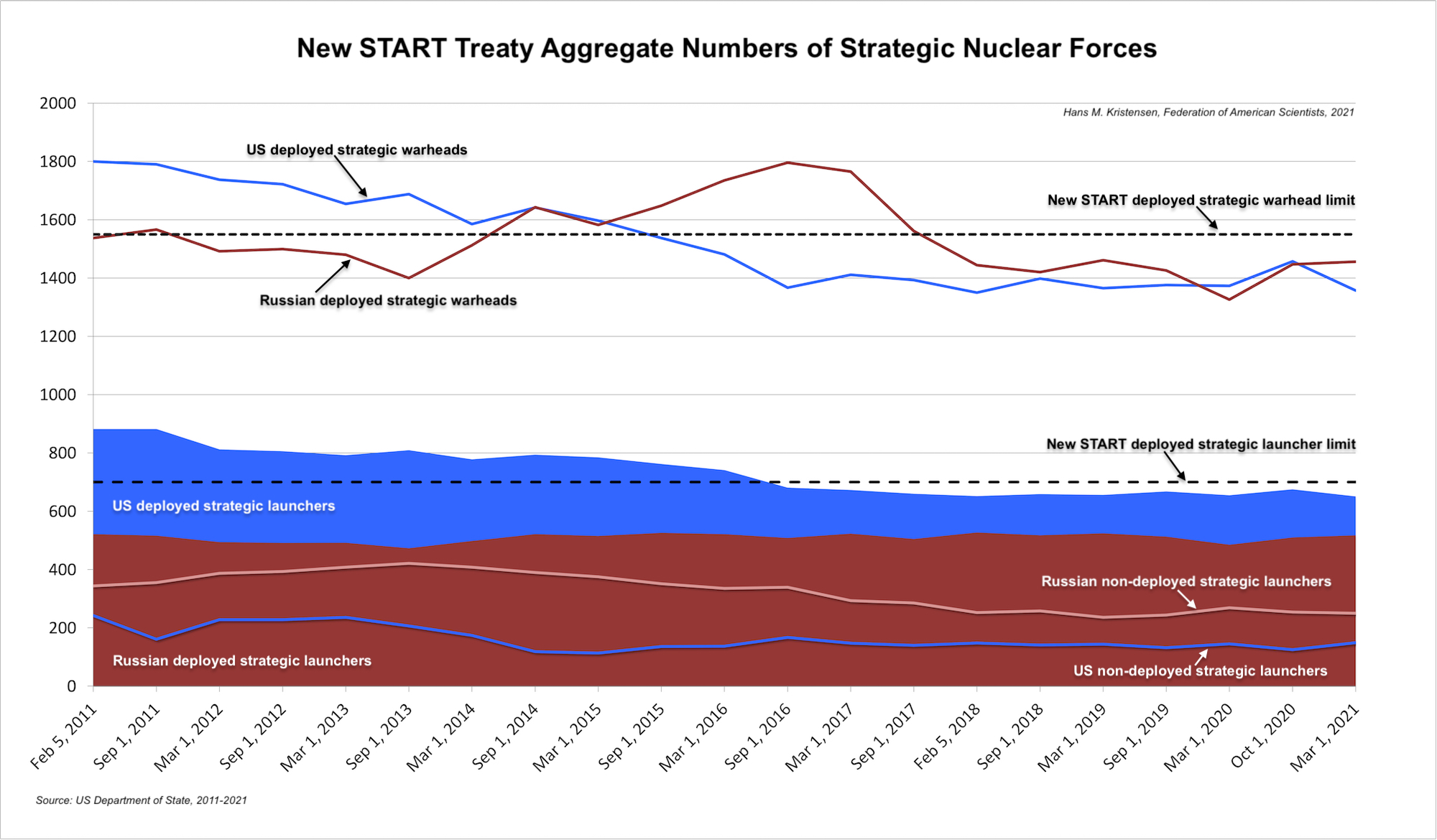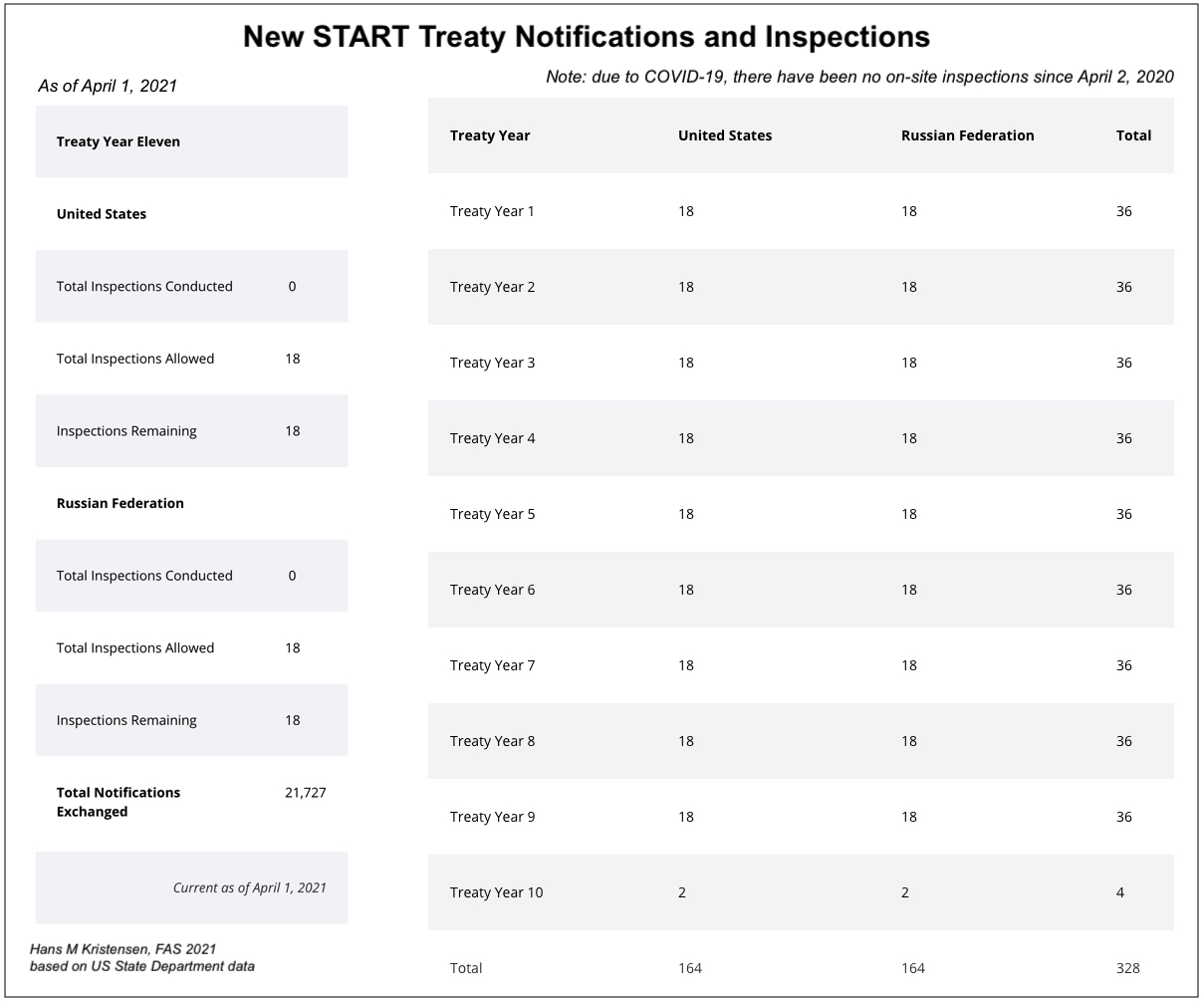STRATCOM Says China Has More ICBM Launchers Than The United States – We Have Questions
In early-February 2023, the Wall Street Journal reported that U.S. Strategic Command (STRATCOM) had informed Congress that China now has more launchers for Intercontinental Ballistic Missiles (ICBMs) than the United States. The report is the latest in a serious of revelations over the past four years about China’s growing nuclear weapons arsenal and the deepening strategic competition between the world’s nuclear weapon states. It is important to monitor China’s developments to understand what it means for Chinese nuclear strategy and intensions, but it is also important to avoid overreactions and exaggerations.
First, a reminder about what the STRATCOM letter says and does not say. It does not say that China has more ICBMs or warheads on them than the United States, or that the United States is at an overall disadvantage. The letter has three findings (in that order):
- The number of ICBMs in the active inventory of China has not exceeded the number of ICBMs in the active inventory of the United States.
- The number of nuclear warheads equipped on such missiles of China has not exceeded the number of nuclear warheads equipped on such missiles of the United States.
- The number of land-based fixed and mobile ICBM launchers in China exceeds the number of ICBM launchers in the United States.
It is already well-known that China is building several hundred new missile silos. We documented many of them (see here, here and here), as did other analysts (here and here). It was expected that sooner or later some of them would be completed and bring China’s total number of ICBM launchers (silo and road-mobile) above the number of US ICBM launchers. That is what STRATCOM says has now happened.
STRATCOM ICBM Counting
The number of Chinese ICBM launchers included in the STRATCOM report to Congress was counted at a cut-off date of October 2022. It is unclear precisely how STRATCOM counts the Chinese silos, but the number appears to include hundreds of silos that were not yet operational with missiles at the time. So, at what point in its construction process did STRATCOM include a silo as part of the count? Does it have to be completely finished with everything ready except a loaded missile?
We have examined satellite photos of every single silo under construction in the three new large missile silo fields (Hami, Julin, and Yumen). It is impossible to determine with certainty from a satellite photo if a silo is completely finished, much less whether it is loaded with a missile. However, the available images indicate it is possible that most of the silos at Hami might have been complete by October 2022, that many of the silos at the Yumen field were still under construction, and that none of the silos at the Julin (Ordos) fields had been completed at the time of STRATCOM’s cutoff date (see image below).
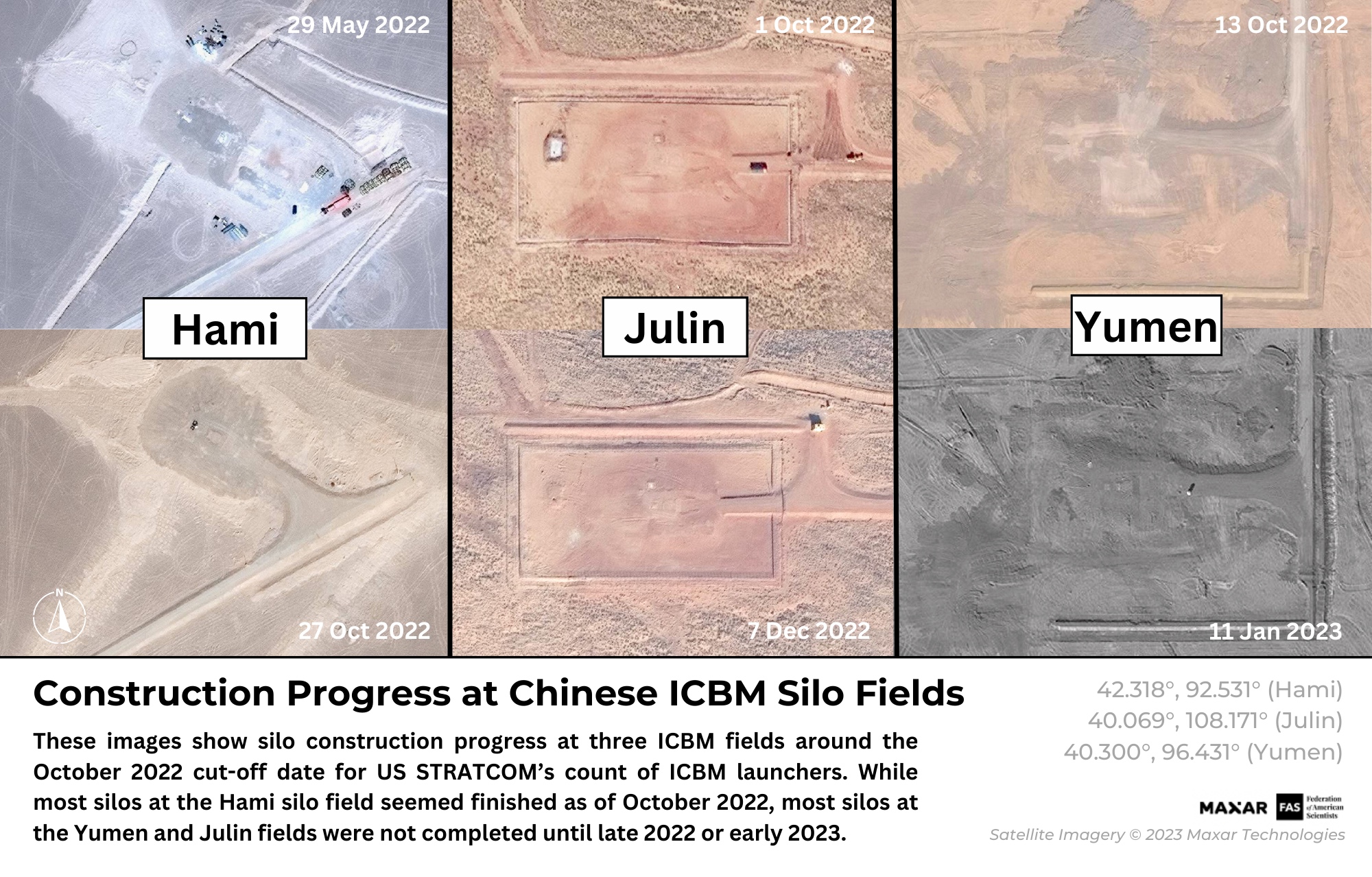
Commercial satellite images help assess STRATCOM claim about China’s missile silos.
The number of Chinese ICBM launchers reported by the Pentagon over the past three years has increased significantly from 100 launchers at the end of 2020, to 300 launchers at the end of 2021, to now more than 450 launchers as of October 2022. That is an increase of 350 launchers in only three years.
To exceed the number of US ICBM launchers as most recently reported by STRATCOM, China would have to have more than 450 launchers (mobile and silo) – the US Air Force has 400 silos with missiles and another 50 empty silos that could be loaded as well if necessary. Without counting the new silos under construction, we estimate that China has approximately 140 operational ICBM launchers with as many missiles. To get to 300 launchers with as many missiles, as the 2022 China Military Power Report (CMPR) estimated, the Pentagon would have to include about 160 launchers from the new silo fields – half of all the silos – as not only finished but with missiles loaded in them. We have not yet seen a missile loading – training or otherwise – on any of the satellite photos. To reach 450 launchers as of October 2022, STRATCOM would have to count nearly all the silos in the three new missile silo fields (see graph below).
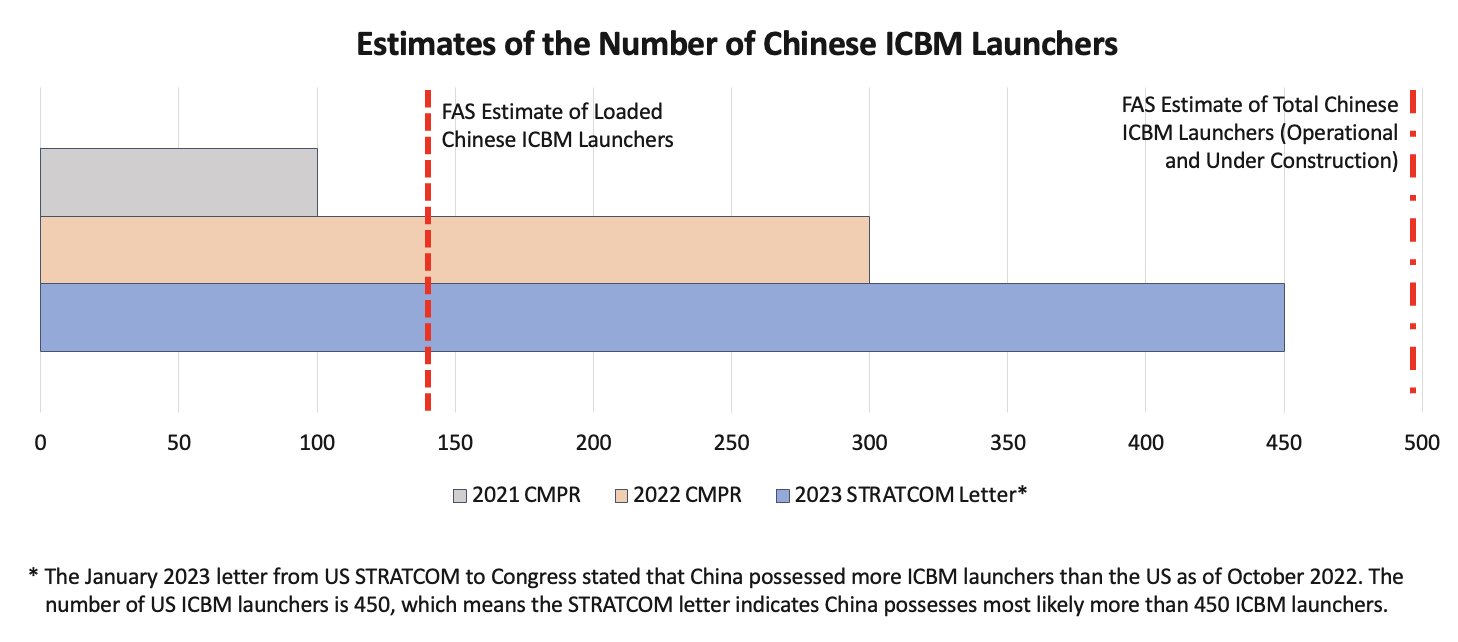
Pentagon estimates of Chinese completed ICBM launchers appear to include hundreds of new silos at three missile silo fields.
The point at which a silo is loaded with a missile depends not only on the silo itself but also on the operational status of support facilities, command and control systems, and security perimeters. Construction of that infrastructure is still ongoing at all the three missile silo fields.
It is also possible that the number of launchers and missiles in the Pentagon estimate is less directly linked. The number could potentially refer to the number of missiles for operational launchers plus missiles produced for launchers that have been more or less completed but not yet loaded with missiles.
All of that to underscore that there is considerable uncertainty about the operational status of the Chinese ICBM force.
However – in time for the Congressional debate on the FY2024 defense budget – some appear to be using the STRATCOM letter to suggest the United States also needs to increase its nuclear arsenal.
Comparing The Full Arsenals
The rapid increase of the Chinese ICBM force is important and unprecedented. Yet, it is also crucial to keep things in perspective. In his response to the STRATCOM letter, Rep. Mike Rogers – the new conservative chairman of the House Armed Services Committee – claimed that China is “rapidly approaching parity with the United States” in nuclear forces. That is not accurate.
Even if China ends up with more ICBMs than the United States and increases its nuclear stockpile to 1,500 warheads by 2035, as projected by the Pentagon, that does not give China parity. The United States has 800 launchers for strategic nuclear weapons and a stockpile of 3,700 warheads (see graph below).
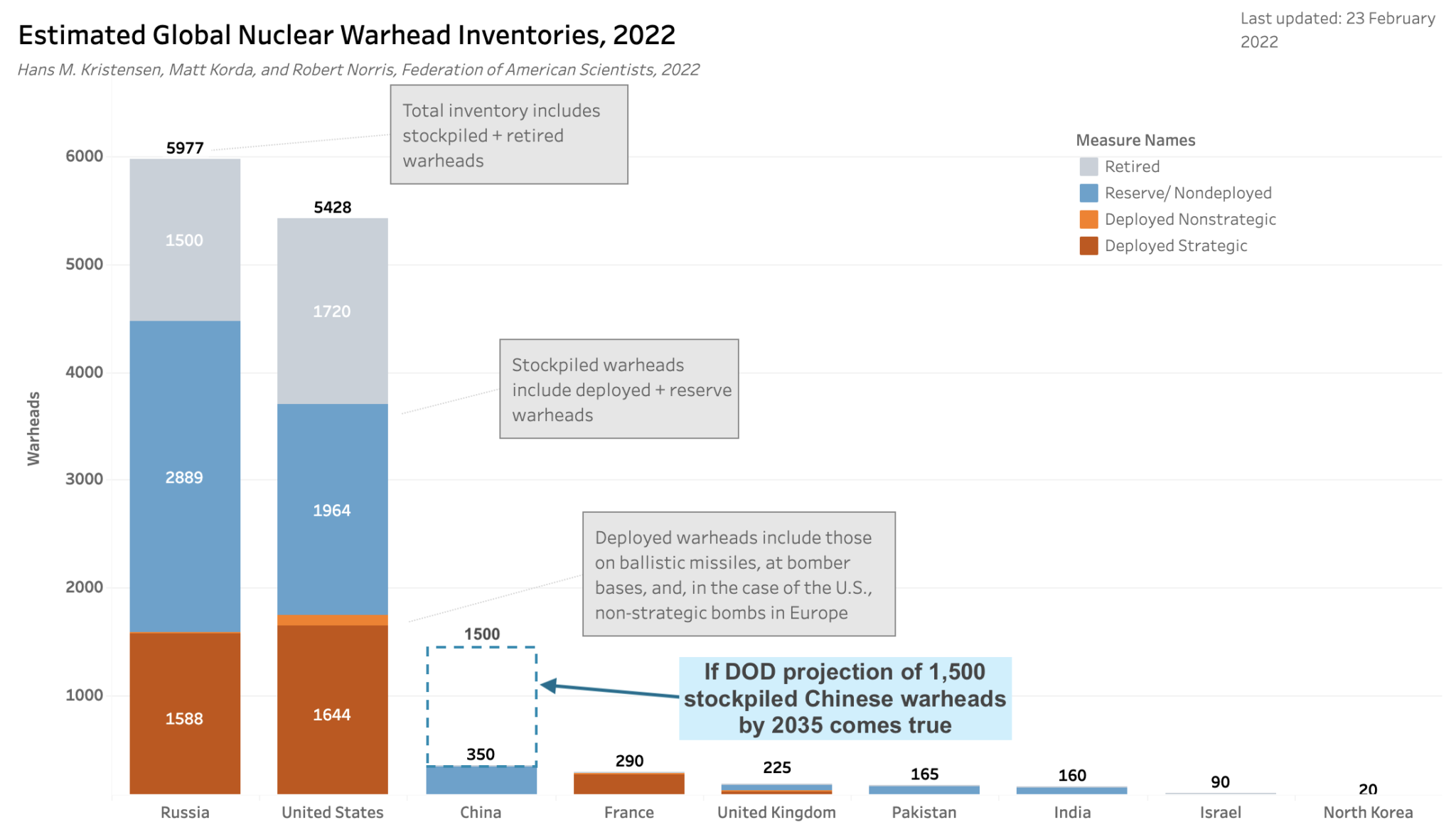
Even if China increases it nuclear weapons stockpile to 1,500 by 2035, it will only make up a fraction of the much larger US and Russian stockpiles.
The worst-case projection about China’s nuclear expansion assumes that it will fill everything with missiles with multiple warheads. In reality, it is unknown how many of the new silos will be filled with missiles, how many warheads each missile will carry, and how many warheads China can actually produce over the next decade.
The nuclear arsenals do not exist in a vacuum but are linked to the overall military capabilities and the policies and strategies of the owners.
The Political Dimension
STRATCOM initially informed Congress about its assessment that the number of Chinese ICBM launchers exceeded that of the United States back in November 2022. But the letter was classified, so four conservative members of the Senate and House armed services committees reminded STRATCOM that it was required to also release an unclassified version. They then used the unclassified letter to argue for more nuclear weapons stating (see screen shot of Committee web page below):
“We have no time to waste in adjusting our nuclear force posture to deter both Russia and China. This will have to mean higher numbers and new capabilities.” (Emphasis added.)
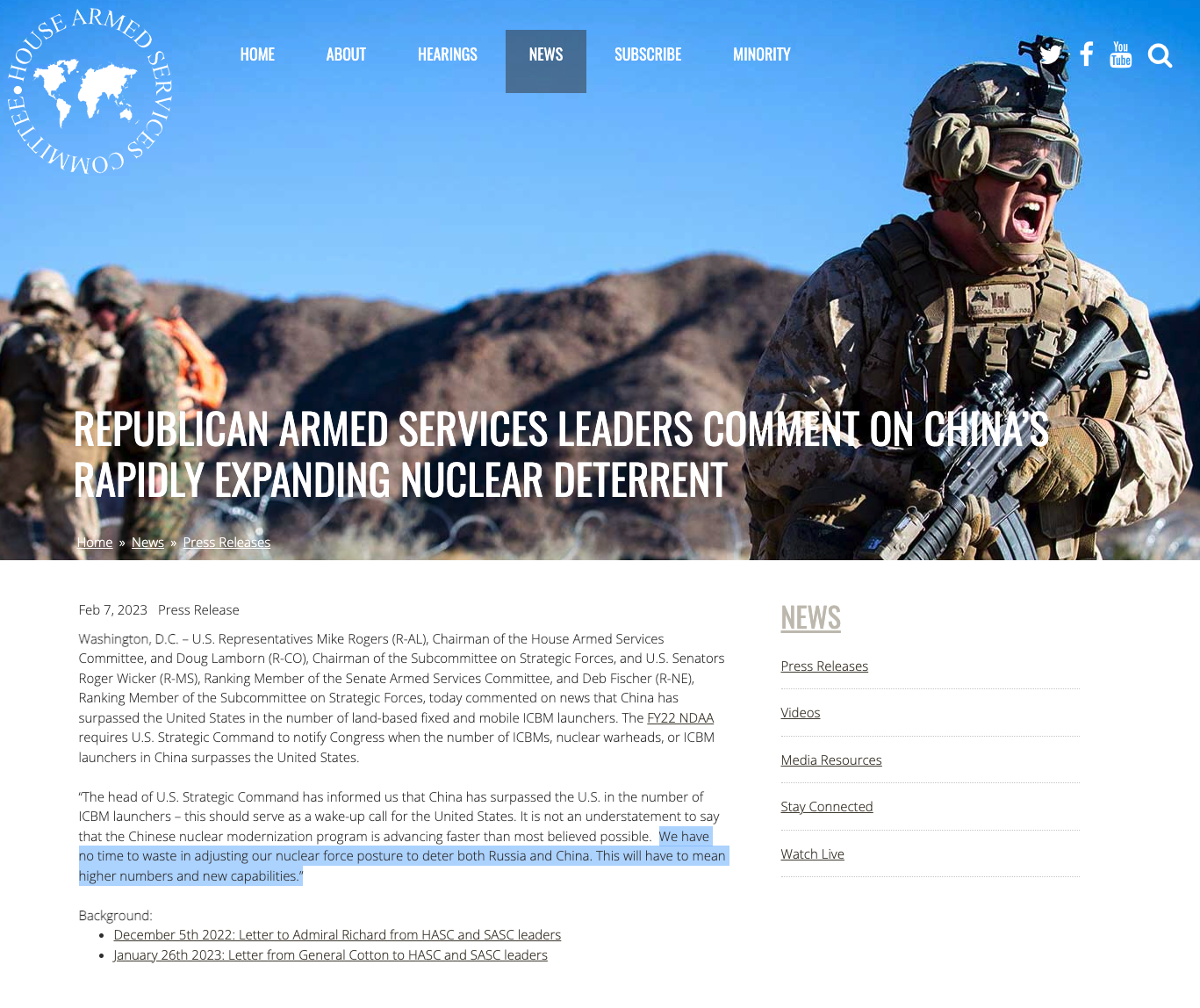
Lawmakers immediately used STRATCOM assessment of Chinese ICBM launchers to call for more US nuclear weapons.
Although defense contractors probably would be happy about that response, it is less clear why ‘higher numbers’ are necessary for US nuclear strategy. Increasing US nuclear weapons could in fact end up worsening the problem by causing China and Russia to increase their arsenals even further. And as we have already seen, that would likely cause a heightened demand for more US nuclear weapons.
We have seen this playbook before during the Cold War nuclear arms race. Only this time, it’s not just between the United States and the Soviet Union, but with Russia and a growing China.
Even before China will reach the force levels projected by the Pentagon, the last remaining arms control treaty with Russia – the New START Treaty – will expire in February 2026. Without a follow-on agreement, Russia could potentially double the number of warheads it deploys on its strategic launchers.
Even if the defense hawks in Congress have their way, the United States does not seem to be in a position to compete in a nuclear arms race with both Russia and China. The modernization program is already overwhelmed with little room for expansion, and the warhead production capacity will not be able to produce large numbers of additional nuclear weapons for the foreseeable future.
What the Chinese nuclear buildup means for Chinese nuclear policy and how the United States should respond to it (as well as to Russia) is much more complicated and important to address than a rush to get more nuclear weapons. It would be more constructive for the United States to focus on engaging with Russia and China on nuclear risk reduction and arms control rather than engage in a build-up of its nuclear forces.
Additional Information:
Status of World Nuclear Forces
This research was carried out with generous contributions from the John D. and Catherine T. MacArthur Foundation, the New-Land Foundation, Ploughshares Fund, the Prospect Hill Foundation, Longview Philanthropy, the Stewart R. Mott Foundation, the Future of Life Institute, Open Philanthropy, and individual donors.
If Arms Control Collapses, US and Russian Strategic Nuclear Arsenals Could Double In Size
On January 31st, the State Department issued its annual Report to Congress on the Implementation of the New START Treaty, with a notable––yet unsurprising––conclusion:
“Based on the information available as of December 31, 2022, the United States cannot certify the Russian Federation to be in compliance with the terms of the New START Treaty.”
This finding was not unexpected. In August 2022, in response to a US treaty notification expressing an intent to conduct an inspection, Russia invoked an infrequently used treaty clause “temporarily exempting” all of its facilities from inspection. At the time, Russia attempted to justify its actions by citing “incomplete” work regarding Covid-19 inspection protocols and perceived “unilateral advantages” created by US sanctions; however, the State Department’s report assesses that this is “false:”
“Contrary to Russia’s claim that Russian inspectors cannot travel to the United States to conduct inspections, Russian inspectors can in fact travel to the United States via commercial flights or authorized inspection airplanes. There are no impediments arising from U.S. sanctions that would prevent Russia’s full exercise of its inspection rights under the Treaty. The United States has been extremely clear with the Russian Federation on this point.”
Instead, the report suggests that the primary reason for suspending inspections “centered on Russian grievances regarding U.S. and other countries’ measures imposed on Russia in response to its unprovoked, full-scale invasion of Ukraine.”
Echoing the findings of the report, on February 1st, Cara Abercrombie, deputy assistant to the president and coordinator for defense policy and arms control for the White House National Security Council, stated in a briefing at the Arms Control Association that the United States had done everything in its power to remove pandemic- and sanctions-related limitations for Russian inspectors, and that “[t]here are absolutely no barriers, as far as we’re concerned, to facilitating Russian inspections.”
Nonetheless, Russia has still not rescinded its exemption and also indefinitely postponed a scheduled meeting of the Bilateral Consultative Commission in November. In a similar vein, this is believed to be tied to US support for Ukraine, as indicated by Deputy Foreign Minister Sergei Ryabkov who said that arms control “has been held hostage by the U.S. line of inflicting strategic defeat on Russia,” and that Russia was “ready for such a scenario” if New START expired without a replacement.
These two actions, according to the United States, constitute a state of “noncompliance” with specific clauses of New START. It is crucial to note, however, the distinction between findings of “noncompliance” (serious, yet informal assessments, often with a clear path to reestablishing compliance), “violation” (requiring a formal determination), and “material breach” (where a violation rises to the level of contravening the object or purpose of the treaty).
It is also important to note that the United States’ findings of Russian noncompliance are not related to the actual number of deployed Russian warheads and launchers. While the report notes that the lack of inspections means that “the United States has less confidence in the accuracy of Russia’s declarations,” the report is careful to note that “While this is a serious concern, it is not a determination of noncompliance.” The report also assesses that “Russia was likely under the New START warhead limit at the end of 2022” and that Russia’s noncompliance does not threaten the national security interests of the United States.
The high stakes of failure: worst-case force projections after New START’s expiry
Both the US and Russia have meticulously planned their respective nuclear modernization programs based on the assumption that neither country will exceed the force levels currently dictated by New START. Without a deal after 2026, that assumption immediately disappears; both sides would likely default to mutual distrust amid fewer verifiable data points, and our discourse would be dominated by worst case thinking about how both countries’ arsenals would grow in the future.
For an example of this kind of thinking, look no further than the new Chair of the House Armed Services Committee, who argued in response to the State Department’s findings of Russian noncompliance that “The Joint Staff needs to assume Russia has or will be breaching New START caps.” As previously mentioned, the State Department report explicitly states that they have only found Russia to be noncompliant on facilitating inspections and BCC meetings, not on deployed warheads and launchers.
It is clear that the longer that these compliance issues persist, the more they will ultimately hinder US-Russia negotiations over a follow-on treaty, which is necessary in order to continue the bilateral strategic arms control regime beyond New START’s expiry in February 2026. As Amb. Steve Pifer, non-resident Senior Fellow at the Brookings Institution, noted during the ACA webinar, “We have three years until New START expires. That seems like a lot of time, but it’s not a long of time if you’re going to try to do something ambitious.”
To that end, both sides should be clear-eyed about the stakes, and more specifically, about what happens if they fail to secure a new deal limiting strategic offensive arms.
The United States has a significant upload capacity on its strategic nuclear forces, where it can bring extra warheads out of storage and add them to the deployed missiles and bombers. Although all 400 deployed US ICBMs currently only carry a single warhead, about half of them use the Mk21A reentry vehicle that is capable of carrying up to three warheads each. Moreover, the United States has an additional 50 “warm” ICBM silos which could be reloaded with missiles if necessary. With these potential additions in mind, the US ICBM force could potentially more than double from 400 to 950 warheads.
In the absence of treaty limitations, the United States could also upload each of its deployed Trident SLBMs with a full complement of eight warheads, rather than the current average of four to five. Factoring in the small numbers of submarines that are assumed to be out for maintenance at any given time, then the United States could approximately double the number of warheads deployed on its SLBMs, to roughly 1,920. The United States could potentially also reactivate the four launch tubes on each submarine that it deactivated to meet the New START limit, thus adding 56 missiles with 448 warheads to the fleet. However, this possibility is not reflected in the table because it is unlikely that the United States would choose to reconstitute the additional four launch tubes on each submarine given their imminent replacement with the next-generation Columbia-class.
Either of these actions would likely take months to complete, particularly given the complexities involved with uploading additional warheads on ICBMs. Moreover, ballistic missile submarines would have to return to port on a rotating schedule in order to be uploaded with additional warheads. However, deploying additional warheads to US bomber bases could be done very quickly, and the United States could potentially upload nearly 700 cruise missiles and bombs on its B-52 and B-2 bombers.
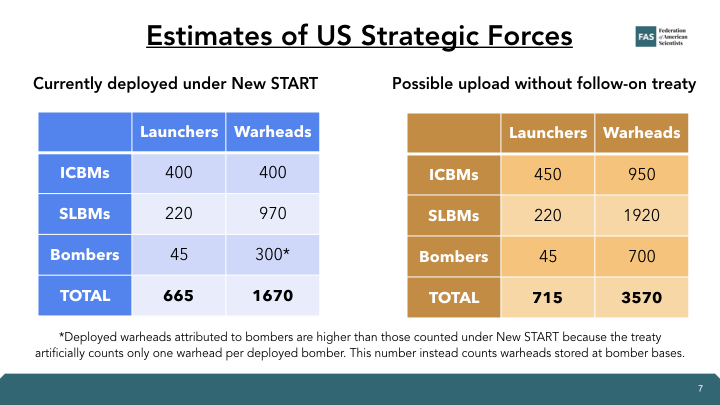
[Note: These numbers are projections based off of estimates; they are not predictions or endorsements. They also do not take into account how the number of available launchers and warheads will change when ongoing modernization programs are eventually completed, as this is unlikely to occur before New START’s expiry in 2026]
Russia also has a significant upload capacity, especially for its ICBMs. Several of Russia’s existing ICBMs are thought to have been downloaded to a smaller number of warheads than their maximum capacities, in order to meet the New START force limits. As a result, without the limits imposed by New START, Russia’s ICBM force could potentially increase from approximately 834 warheads to roughly 1,197 warheads.
Warheads on submarine-launched ballistic missiles onboard some of Russia’s SSBNs are also thought to have been reduced to a lower number to meet New START limits. Without these limitations, the number of deployed warheads could potentially be increased from an estimated 640 to approximately 832 (also with a small number of SSBNs assumed to be out for maintenance). As in the US case, Russian bombers could be loaded relatively quickly with hundreds of nuclear weapons. The number is highly uncertain but assuming approximately 50 bombers are operational, the number of warheads could potentially be increased to nearly 600.
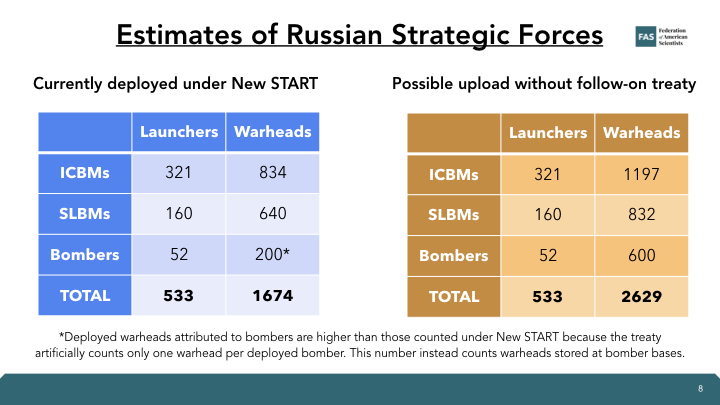
Slide showing estimates of Russian strategic forces, as well as a projection showing the possible upload without a follow-on treaty. Numbers mirror those found in the article text.
Combined, if both countries uploaded their delivery systems to accommodate the maximum number of possible warheads, both sets of arsenals would approximately double in size. The United States would have more deployable strategic warheads but Russia would still have a larger total arsenal of operational nuclear weapons, given its sizable stockpile of nonstrategic nuclear warheads which are not treaty-accountable.
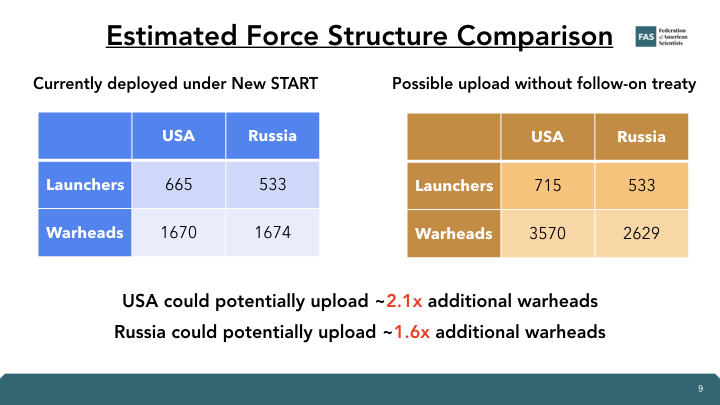
Slide showing comparison estimates of US and Russian strategic forces, as well as a projection showing the possible upload without a follow-on treaty. Numbers mirror those found in the article text.
Moreover, there are expected consequences beyond the offensive strategic nuclear forces that New START regulates. If the verification regime and data exchanges elapse, both countries are likely to enhance their intelligence capabilities to make up for the uncertainty regarding the other side’s nuclear forces. Both countries are also likely to invest more into what they perceive will increase their overall military capabilities, such as conventional missile forces, nonstrategic nuclear forces, and missile defense.
These moves could trigger reactions in other nuclear-armed states, some of whom might also decide to increase their nuclear forces and the role they play in their military strategies. In particular, it is becoming increasingly clear that China appears to no longer be satisfied with just a couple hundred nuclear weapons to ensure its security, and in a shift from longstanding doctrine, may now be looking to size its own nuclear force closer to the size of the US and Russian deployed nuclear forces.
Some US former defense officials have suggested that the United States needs to increase its deployed nuclear force to compensate for the increased nuclear arsenal that China is already building and an alleged increase in Russian non-strategic nuclear weapons––either by negotiating a higher treaty limit with Russia or withdrawing from the New START treaty.
But doing so would not solve the problem and could put the United States on a path where it would in fact face even greater numbers of Russian and Chinese nuclear weapons in the future. A higher treaty warhead limit would obviously increase – not reduce – the number of Russian warheads aimed at the United States; and pulling out of New START would likely cause Russia to deploy even more weapons. Moreover, a significant increase in the size of US and Russian deployed nuclear forces could cause China to increase its arsenal even further. Such developments could subsequently have ripple effects for India, Pakistan, and elsewhere – developments that would undermine, rather than improve, US and international security.
Uploading more warheads is not necessary to maintain deterrence
It is important to note that even if such worst-case scenarios were to occur, in the past the Department of Defense and the Director of National Intelligence have assessed that even a significant Russian increase of deployed nuclear warheads would not have a deleterious effect on US deterrence capabilities. A 2012 joint study assessed:
“[E]ven if significantly above the New START Treaty limits, [Russia’s deployment of additional nuclear warheads] would have little to no effect on the U.S. assured second-strike capabilities that underwrite our strategic deterrence posture. The Russian Federation, therefore, would not be able to achieve a militarily significant advantage by any plausible expansion of its strategic nuclear forces, even in a cheating or breakout scenario under the New START Treaty, primarily because of the inherent survivability of the planned U.S. strategic force structure, particularly the OHIO-class ballistic missile submarines, a number of which are at sea at any given time.”
Although the political situation has dramatically changed over the past decade since the study was published, this particular deterrence dynamic has not. The United States’ second-strike capabilities remain as secure today––even among Russia’s noncompliance and China’s nuclear buildup––as they did a decade ago. As a result, it seems clear that although uploading additional warheads onto US systems may seem like a politically strong response, it would not offer the United States any additional advantage that it does not already possess, and would likely trigger developments that would not be in its national security interest.
—
Background Information:
- “The Long View: Strategic Arms Control After the New START Treaty,” FAS Nuclear Notebook, Bulletin of the Atomic Scientists, November 2022.
- “United States nuclear weapons, 2023,” FAS Nuclear Notebook, Bulletin of the Atomic Scientists, January 2023.
- “Russian nuclear weapons, 2022,” FAS Nuclear Notebook, Bulletin of the Atomic Scientists, February 2022.
- Status of World Nuclear Forces, Federation of American Scientists
This research was carried out with generous contributions from the John D. and Catherine T. MacArthur Foundation, the New-Land Foundation, Ploughshares Fund, the Prospect Hill Foundation, Longview Philanthropy, the Stewart R. Mott Foundation, the Future of Life Institute, Open Philanthropy, and individual donors.
The C-17A Has Been Cleared To Transport B61-12 Nuclear Bomb To Europe
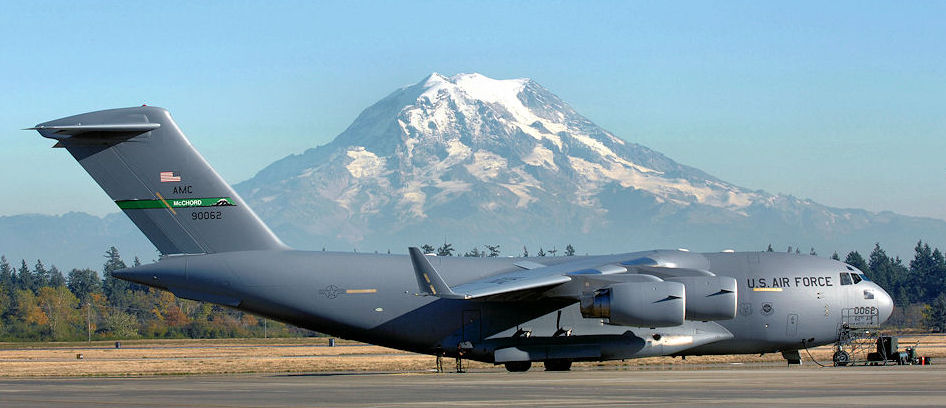
C-17As of the 62nd Airlift Wing at Joint Base Lewis-McChord near Seattle have been cleared to transport new B61-12 nuclear bomb.
In November 2022, the Air Force updated its safety rules for airlift of nuclear weapons to allow the C-17A Globemaster III aircraft to transport the new B61-12 nuclear bomb.
The update, accompanied by training and certification of the aircraft and crews, cleared the C-17A to transport the newest U.S. nuclear weapon to bases in the United States and Europe.
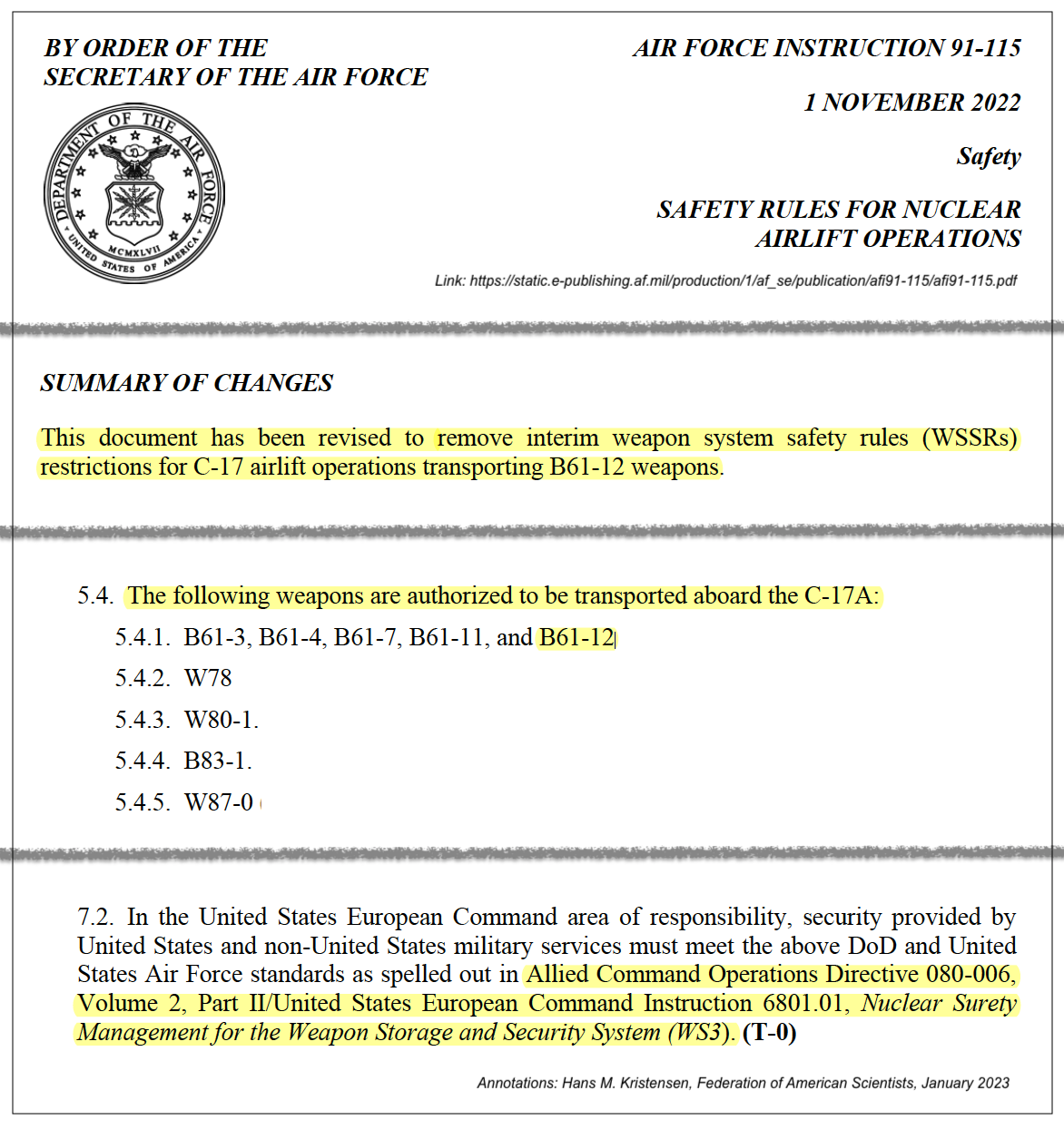
An updated USAF Instruction in November 2022 removed restrictions for C-17A transport of the new B61-12 nuclear bomb to bases in the United States and Europe.
The C-17As of the 62nd Airlift Wing at Joint Base Lewis-McChord serve as the Prime Nuclear Airlift Force (PNAF), the only airlift wing that is authorized to transport the Air Force’s nuclear warheads.
The updated Air Force instruction does not, as inaccurately suggested by some, confirm that shipping of the weapons began in December. But it documents some of the preparations needed to do so.
Politico reported in October last year that the US had accelerated deployment of the B61-12 from Spring 2023 to December 2022. Two unnamed US officials said the US told NATO about the schedule in October.
But a senior Pentagon official subsequently dismissed the Politico report, saying “nothing has changed on the timeline. There is no speeding up because of any Ukraine crisis, the B61-12 is on the same schedule it’s always been on.”
Although the DOD official denied there had been a change in the schedule, he did not deny that transport would begin in December.
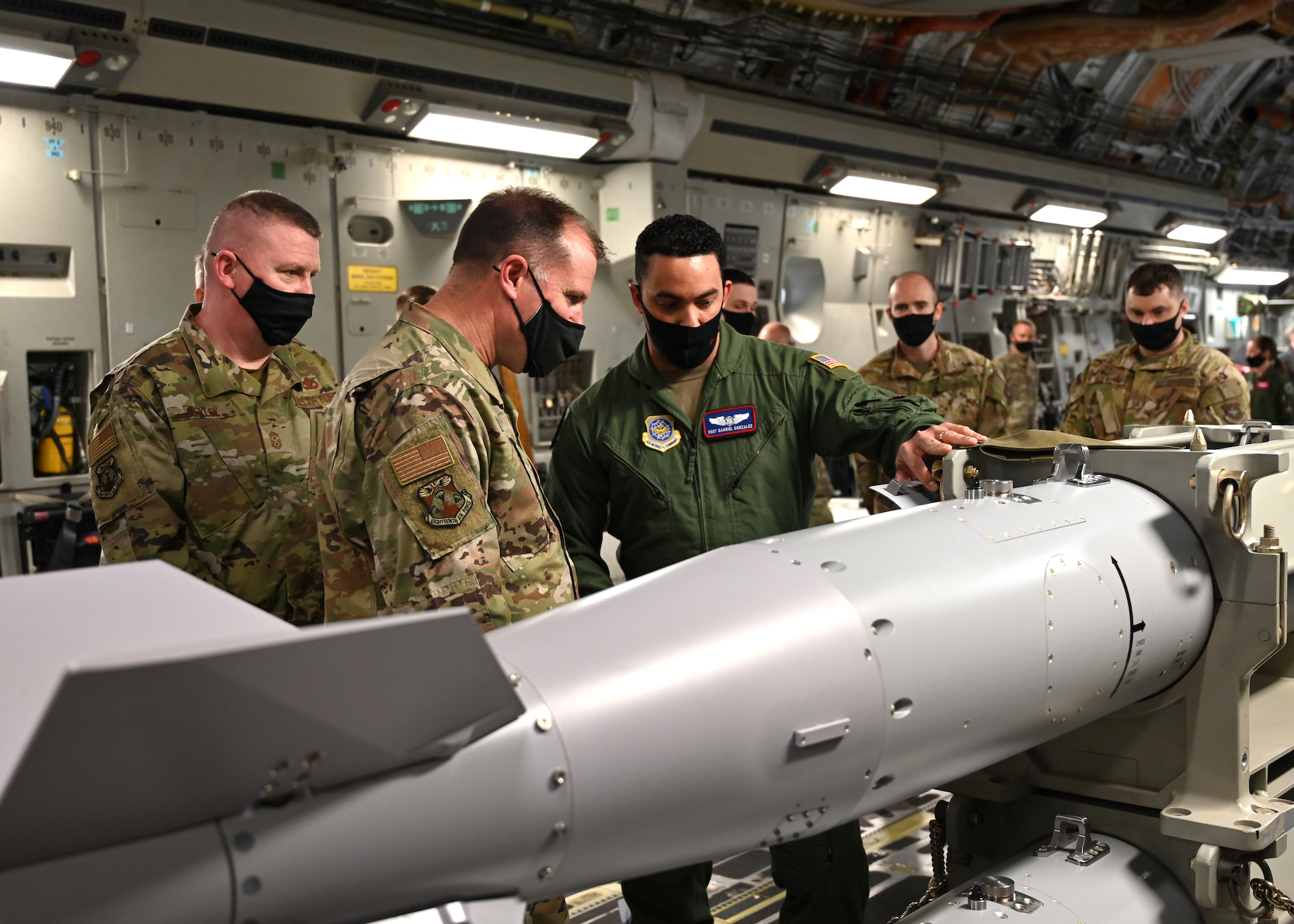
Two unarmed B61-12 trainers are loaded on a C-17A during an exercise at Joint Base Lewis-McChord AFB in April 2021. Image: U.S. Air Force.
The B61-12 production scheduled had slipped repeatedly. Initially, the plan was to begin full-scale production in early-2019. By September 2022, the National Nuclear Security Administration (NNSA) was still awaiting approval to begin full-scale production. Finally, in October 2022, NNSA confirmed to FAS that the B61-12 was in full-scale production.
The B61-12 is intended as an upgrade and eventual replacement for all current nuclear gravity bombs, including the B61-3, -4, -7, and probably eventually also the B61-11 and B83-1. To that end, it combines and improves upon various aspects of existing bombs: it uses a modified version of the B61-4 warhead with several lower- and medium-yield options (0.3-50 kilotons). It compensates for its smaller explosive yield (relative to the maximum yields of the B61-7 and -11) by including a guided tail-kit to increase accuracy, as well as a limited earth-penetration capability.
At this point in time, it is unknown if B61-12 shipments to Europe have begun. If not, it appears to be imminent. That said, deployment will probably not happen in one move but gradually spread to more and more bases depending on certification and construction at each base.
There are currently six active bases in five European countries with about 100 B61 bombs present in underground Weapons Storage and Security Systems (WS3) inside aircraft shelters. A seventh site in Germany (Ramstein Air Base) is active without weapons present and an eighth site – RAF Lakenheath – has recently been added to the list of WS3 sites being modernized. The revitalization of Lakenheath’s nuclear storage bunkers does not necessarily indicate that US nuclear weapons will return to UK soil, especially since as recently as December 2021, NATO’s Secretary General stated that “we have no plans of stationing any nuclear weapons in any other countries than we already have . . . ” However, the upgrade could be intended to increase NATO’s ability to redistribute the B61 bombs in times of heightened tensions, or to potentially move them out of Turkey in the future. In addition, four other sites have inactive (possibly mothballed) vaults (see map below).

This research was carried out with generous contributions from the John D. and Catherine T. MacArthur Foundation, the New-Land Foundation, the Ploughshares Fund, the Prospect Hill Foundation, Longview Philanthropy, the Stewart R. Mott Foundation, the Future of Life Institute, Open Philanthropy, and individual donors.
The 2022 Nuclear Posture Review: Arms Control Subdued By Military Rivalry
On 27 October 2022, the Biden administration finally released an unclassified version of its long-delayed Nuclear Posture Review (NPR). The classified NPR was released to Congress in March 2022, but its publication was substantially delayed––likely due to Russia’s invasion of Ukraine.
Compared with previous NPRs, the tone and content come closest to the Obama administration’s NPR from 2010. However, it contains significant adjustments because of the developments in Russia and China. (See also our global overview of nuclear arsenals)
Despite the challenges presented by Russia and China, the NPR correctly resists efforts by defense hawks and nuclear lobbyists to add nuclear weapons to the U.S. arsenal and delay the retirement of older types. Instead, the NPR seeks to respond with adjustments in the existing force posture and increase integration of conventional and nuclear planning.
Although Joe Biden during his presidential election campaign spoke strongly in favor of adopting no-first-use and sole-purpose policies, the NPR explicitly rejects both for now.
From an arms control and risk reduction perspective, the NPR is a disappointment. Previous efforts to reduce nuclear arsenals and the role that nuclear weapons play have been subdued by renewed strategic competition abroad and opposition from defense hawks at home.
Even so, the NPR concludes it may still be possible to reduce the role that nuclear weapons play in scenarios where nuclear use may not be credible.
Unlike previous NPRs, the 2022 version is embedded into the National Defense Strategy document alongside the Missile Defense Review.
Below is our summary and analysis of the major portions of the NPR:
The Nuclear Adversaries
The NPR identifies four potential adversaries for U.S. nuclear weapons planning: Russia, China, North Korea, and Iran. Of these, Russia and China are obviously the focus because of Russia’s large arsenal and aggressive behavior and because of China’s rapidly increasing arsenal. The NPR projects that “[b]y the 2030s the United States will, for the first time in its history, face two major nuclear powers as strategic competitors and potential adversaries.” This echoes previous statements from high-ranking US military leaders, including the former and incoming Commanders of US Strategic Command although the NPR appears less “the sky is falling.”
China: Given that the National Defense Strategy is largely focused on China, it is unsurprising that the NPR declares China to be “the overall pacing challenge for U.S. defense planning and a growing factor in evaluating our nuclear deterrent.”
Echoing the findings of the previous year’s China Military Power Report, the NPR suggests that “[t]he PRC likely intends to possess at least 1,000 deliverable warheads by the end of the decade.” According to the NPR, China’s more diverse nuclear arsenal “could provide the PRC with new options before and during a crisis or conflict to leverage nuclear weapons for coercive purposes, including military provocations against U.S. Allies and partners in the region.”
See also our Nuclear Notebook on Chinese nuclear forces.
Russia: The NPR presents harsh language about Russia, in particular surrounding its behavior around the invasion of Ukraine. In contrast to the Trump administration’s NPR, the assumptions surrounding a potential low-yield “escalate-to-deescalate” policy have been toned down; instead the NPR simply states that Russia is diversifying its arsenal and that it views its nuclear weapons as “a shield behind which to wage unjustified aggression against [its] neighbors.”
The review’s estimate of Russian non-strategic nuclear weapons –– “up to 2,000 –– matches those of previous military statements. In 2021, the Defense Intelligence Agency concluded that Russia “probably possesses 1,000 to 2,000 nonstrategic nuclear warheads.” The State Department said in April 2022 that the estimate includes retired weapons awaiting dismantlement. The subtle language differences reflect a variance in estimates between the different US military departments and agencies.
The NPR also suggests that “Russia is pursuing several novel nuclear-capable systems designed to hold the U.S. homeland or Allies and partners at risk, some of which are also not accountable under New START.” Given that both sides appear to agree that Russia’s new Sarmat ICBM and Avangard hypersonic glide vehicle fit smoothly into the treaty, this statement is likely referring to Russia’s development of its Burevestnik nuclear-powered cruise missile, its Kinzhal air-launched ballistic missile, and its Status-6 Poseidon nuclear torpedo.
It appears that Russia and the United States are at odds over whether these three systems are treaty-accountable weapons. In 2019, then-Under Secretary Andrea Thompson noted during congressional testimony that all three “meet the US criteria for what constitutes a “new kind of strategic offensive arms’ for purposes of New START.” However, Russian officials had previously sent a notice to the United States stating that they “find it inappropriate to characterize new weapons being developed by Russia that do not use ballistic trajectories of flight moving to a target as ‘potential new kinds of Russian strategic offensive arms.’ The arms presented by the President of the Russian Federation on March 1, 2018, have nothing to do with the strategic offensive arms categories covered by the Treaty.”
See also our Nuclear Notebook on Russian nuclear forces.
North Korea: In recent years, North Korea has been overshadowed by China and Russia in the U.S. defense debate. Nonetheless this NPR describes North Korea as a target for U.S. nuclear weapons planning. The NPR bluntly states: “Any nuclear attack by North Korea against the United States or its Allies and partners is unacceptable and will result in the end of that regime. There is no scenario in which the Kim regime could employ nuclear weapons and survive.”
See also our Nuclear Notebook on North Korean nuclear forces.
Iran: The NPR also describes Iran even though it does not have nuclear weapons. Interestingly, although Iran is not in compliance with its NPT obligations and therefore does not qualify for the U.S. negative security assurances, the NPR declares that the United States “relies on non-nuclear overmatch to deter regional aggression by Iran as long as Iran does not possess nuclear weapons.”
Nuclear Declaratory Policy
The NPR reaffirms long-standing U.S. policy about the role of nuclear weapons but with slightly modified language. The role is: 1) Deter strategic attacks, 2) Assure allies and partners, and 3) Achieve U.S. objectives if deterrence fails.
The NPR reiterates the language from the 2010 NPR that the “fundamental role” of U.S. nuclear weapons “is to deter nuclear attacks” and only in “extreme circumstances.” The strategy seeks to “maintain a very high bar for nuclear employment” and, if employment of nuclear weapons is necessary, “seek to end conflict at the lowest level of damage possible on the best achievable terms for the United States and its Allies and partners.”
Deterring “strategic” attacks is a different formulation than the “deterrence of nuclear and non-nuclear attack” language in the 2018 NPR, but the new NPR makes it clear that “strategic” also accounts for existing and emerging non-nuclear attacks: “nuclear weapons are required to deter not only nuclear attack, but also a narrow range of other high consequence, strategic-level attacks.”
Indeed, the NPR makes clear that U.S. nuclear weapons can be used against the full spectrum of threats: “While the United States maintains a very high bar for the employment of nuclear weapons, our nuclear posture is intended to complicate an adversary’s entire decision calculus, including whether to instigate a crisis, initiate armed conflict, conduct strategic attacks using non-nuclear capabilities, or escalate to the use of nuclear weapons on any scale.”
During his presidential campaign, Joe Biden spoke repeatedly in favor of a no-first-use and sole-purpose policy for U.S. nuclear weapons. But the NPR explicitly rejects both under current conditions. The public version of the NPR doesn’t explain why a no-first-use policy against nuclear attack is not possible, but it appears to trim somewhat the 2018 NPR language about an enhanced role of nuclear weapons against non-nuclear strategic attacks. And the stated goal is still “moving toward a sole purpose declaration” when possible in consultation with Allies and partners.
In that context the NPR reiterates previous “negative security assurances” that the United States “will not use or threaten to use nuclear weapons against non-nuclear weapon states that are party to the NPT [Nuclear Non-Proliferation Treaty] and in compliance with their nuclear non-proliferation obligations.”
“For all other states” the NPR warns, “there remains a narrow range of contingencies in which U.S. nuclear weapons may still play a role in deterring attacks that have strategic effect against the United States or its Allies and partners.” That potentially includes Iran, North Korea, and Pakistan.
Interestingly, the NPR states that “hedging against an uncertain future” is no longer a stated (formal) role of nuclear weapons. Hedging has been part of a strategy to be able to react to changes in the threat environment, for example by deploying more weapons or modifying capabilities. The change does not mean that the United States is no longer hedging, but that hedging is part of managing the arsenal, rather than acting as a role for nuclear weapons within US military strategy writ large.
The NPR reaffirms, consistent with the 2013 Nuclear Employment Strategy, that U.S. use of nuclear weapons must comply with the Law of Armed Conflict (LOAC) and that it is U.S. policy “not to purposely threaten civilian populations or objects, and the United States will not intentionally target civilian populations or objects in violation of LOAC.” That means that U.S. nuclear forces cannot attack cities per se (unless they contain military targets).
Nuclear Force Structure
The NPR reaffirms a commitment to the modernization of its nuclear forces, nuclear command and control and communication systems (NC3), and production and support infrastructure. This is essentially the same nuclear modernization program that has been supported by the previous two administrations.
But there are some differences. The NPR also identifies “current and planned nuclear capabilities that are no longer required to meet our deterrence needs.” This includes retiring the B83-1 megaton gravity bomb and cancelling the nuclear sea-launched cruise missile (SLCM-N). These decisions were expected and survived opposition from defense hawks and nuclear lobbyists.
Although the NPR has decided to move forward with retirement of the B83-1 bomb due to increasing limitations on its capabilities and rising maintenance costs, the NPR appears to hint at a replacement weapon “for improved defeat” of hard and deeply buried targets. The new weapon is not identified.
The NPR concludes that “SLCM-N was no longer necessary given the deterrence contribution of the W76-2, uncertainty regarding whether SLCM-N on its own would provide leverage to negotiate arms control limits on Russia’s NSNW, and the estimated cost of SLCM-N in light of other nuclear modernization programs and defense priorities.” This language is more subtle than the administration’s recent statement rebutting Congress’ attempt to fund the SLCM-N, which states:
“The Administration strongly opposes continued funding for the nuclear sea-launched cruise missile (SLCM-N) and its associated warhead. The President’s Nuclear PostureReview concluded that the SLCM-N, which would not be delivered before the 2030s, is unnecessary and potentially detrimental to other priorities. […] Further investment in developing SLCM-N would divert resources and focus from higher modernization priorities for the U.S. nuclear enterprise and infrastructure, which is already stretched to capacity after decades of deferred investments. It would also impose operational challenges on the Navy.
In justifying the cancelation of the SLCM-N, the NPR spells out the existing and future capabilities that adequately enable regional deterrence of Russia and China. This includes the W76-2 (the low-yield warhead for the Trident II D5 submarine-launched ballistic missile proposed and deployed under the Trump administration), globally-deployed strategic bombers, air-launched cruise missiles, and dual-capable fighter aircraft such as as the F-35A equipped with the new B61-12 nuclear bomb.
The NPR concludes that the W76-2 “currently provides an important means to deter limited nuclear use.” However, the review leaves the door open for its possible removal from the force structure in the future: “Its deterrence value will be re-evaluated as the F-35A and LRSO are fielded, and in light of the security environment and plausible deterrence scenarios we could face in the future.”
The review also notes that “[t]he United States will work with Allies concerned to ensure that the transition to modern DCA [dual-capable aircraft] and the B61-12 bomb is executed efficiently and with minimal disruption to readiness.” The release of the NPR coincides with the surprise revelation that the United States has sped up the deployment of the B61-12 in Europe. Previously scheduled for spring 2023, the first B61-12 gravity bombs will now be delivered in December 2022, likely due to Russia’s invasion of Ukraine and Putin’s nuclear belligerency. Given that the Biden administration has previously taken care to emphasize that its modernization program and nuclear exercises are scheduled years in advance and are not responses to Russia’s actions, it is odd that the administration would choose to rush the new bombs into Europe at this time.
The NPR appears to link the non-strategic nuclear posture in Europe more explicitly to recent Russian aggression. “Since Russia’s invasion of Ukraine and the occupation of Crimea in 2014, NATO has taken steps to ensure a modern, ready, and credible NATO nuclear deterrent.” While that is true, some of those steps were already underway before 2014 and would have happened even if Russia had not invaded Ukraine. This includes extensive modernizations at the bases and of the weapons and adding the United Kingdom to the nuclear storage upgrades. But the NPR also states that “Further steps are needed to fully adapt these forces to current and emerging security conditions,” including to “enhance the readiness, survivability and effectiveness of the DCA mission across the conflict spectrum, including through enhanced exercises…”
In the Pacific region, the NPR continues and enhances extended deterrence with U.S. capabilities and deepened consultation with Allies and partners. The role of Australia appears to be increasing. An overall goal is to “better synchronize the nuclear and non-nuclear elements of deterrence” and to “leverage Ally and partner non-nuclear capabilities that can support the nuclear nuclear deterrence mission.” The last part sounds similar to the so-called SNOWCAT mission in NATO where Allies support the nuclear strike mission with non-nuclear capabilities.
Nuclear-Conventional Integration
Although the integration of nuclear and conventional capabilities into strategic deterrence planning has been underway for years, the NPR seeks to deepen it further. It “underscores the linkage between the conventional and nuclear elements of collective deterrence and defense” and adopts “an integrated deterrence approach that works to leverage nuclear and non-nuclear capabilities to tailor deterrence under specific circumstances.”
This is not only intended to make deterrence more flexible and less nuclear focused when possible, but it also continues the strategy outlined in the 2010 NPR and 2013 Nuclear Employment Guidance to reduce reliance on nuclear weapons by relying more on new conventional capabilities.
According to the NPR, “Non-nuclear capabilities may be able to complement nuclear forces in strategic deterrence plans and operations in ways that are suited to their attributes and consistent with policy on how they are employed.” Although further integration will take time, the NPR describes “how the Joint Force can combine nuclear and non-nuclear capabilities in complementary ways that leverage the unique attributes of a multi-domain set of forces to enable a range of deterrence options backstopped by a credible nuclear deterrent.” An important part of this integration is to “better synchronize nuclear and non-nuclear planning, exercises, and operations.”
Beyond force structure issues, this effort also appears to be a way to “raise the nuclear threshold” by reducing reliance on nuclear weapons but still endure in regional scenarios where an adversary escalates to limited nuclear use. In contrast, the 2018 NPR sought low-yield non-strategic “nuclear supplements” for such a scenario, and specifically named a Russian so-called “escalate-to-deescalate” scenario as a potentially possibility for nuclear use.
Moreover, conventional integration can also serve to reduce reliance on nuclear weapons in response to non-nuclear strategic attacks, and could therefore pave the way for a sole-purpose policy in the future (see also An Integrated Approach to Deterrence Posture by Adam Mount and Pranay Vaddi).
Finally, increasing conventional capabilities in deterrence planning also allows for deeper and better integration of Allies and partners without having to rely on more controversial nuclear arrangements.
A significant challenge of deeper nuclear-conventional integration in strategic deterrence is to ensure that it doesn’t blur the line between nuclear and conventional war and inadvertently increase nuclear signaling during conventional operations.
Arms Control and Non-Proliferation
The NPR correctly concludes that deterrence alone will not reduce nuclear dangers and reaffirms the U.S. commitment to arms control, risk reduction, and nonproliferation. It does so by stating that the United States will pursue “a comprehensive and balanced approach” that places “renewed emphasis on arms control, non-proliferation, and risk reduction to strengthen stability, head off costly arms races, and signal our desire to reduce the salience of nuclear weapons globally.”
The Biden administration’s review contains significantly more positive language on arms control than can be found in the Trump administration’s NPR. The NPR concludes that “mutual, verifiable nuclear arms control offers the most effective, durable and responsible path to achieving a key goal: reducing the role of nuclear weapons in U.S. strategy.”
In that vein, the review states a willingness to “expeditiously negotiate a new arms control framework to replace New START,” as well as an expansive recommitment to the Non-Proliferation Treaty (NPT), the Comprehensive Nuclear-Test-Ban Treaty” (CTBT), and the Fissile Material Cutoff Treaty (FMCT). However, the authors take a negative view of the Treaty on the Prohibition of Nuclear Weapons (TPNW), stating that the United States does not “consider the TPNW to be an effective tool to resolve the underlying security conflicts that lead states to retain or seek nuclear weapons.”
Although the NPR states that “major changes” in the role of U.S. nuclear weapons against Russia and China will require verifiable reductions and constraints on their nuclear forces, it also concludes that there “is some opportunity to reduce the role of nuclear weapons in our strategies for [China] and Russia in circumstances where the threat of a nuclear response may not be credible and where suitable non-nuclear options may exist or may be developed.” The NPR does not identify what those scenarios are.
Looking Ahead
Many of the activities described in the NPR are already well underway. Now that the NPR has been completed and published, the Pentagon will produce an NPR implementation plan that identifies specific decisions to be carried out.
Flowing from the reviews that were done in preparation of the NPR, the White House will move forward with an update to the nuclear weapons employment guidance. This guidance will potentially include changes to the strike plans and the assumptions and the assumptions and requirements that underpin them.
The Biden administration must use this opportunity to scrutinize more closely the simulations and analysis that U.S. Strategic Command is using to set nuclear force structure requirements.
––
Additional analysis can be found on our FAS Nuclear Posture Review Resource Page.
For an overview of global modernization programs, see our annual contribution to the SIPRI Yearbook and our Status of World Nuclear Forces webpage. Individual country profiles are available in various editions of the FAS Nuclear Notebook, which is published by the Bulletin of Atomic Scientists and is freely available to the public.
This research was carried out with generous contributions from the John D. and Catherine T. MacArthur Foundation, the New-Land Foundation, the Ploughshares Fund, the Prospect Hill Foundation, Longview Philanthropy, the Stewart R. Mott Foundation, the Future of Life Institute, Open Philanthropy, and individual donors.
NATO Steadfast Noon Exercise And Nuclear Modernization in Europe
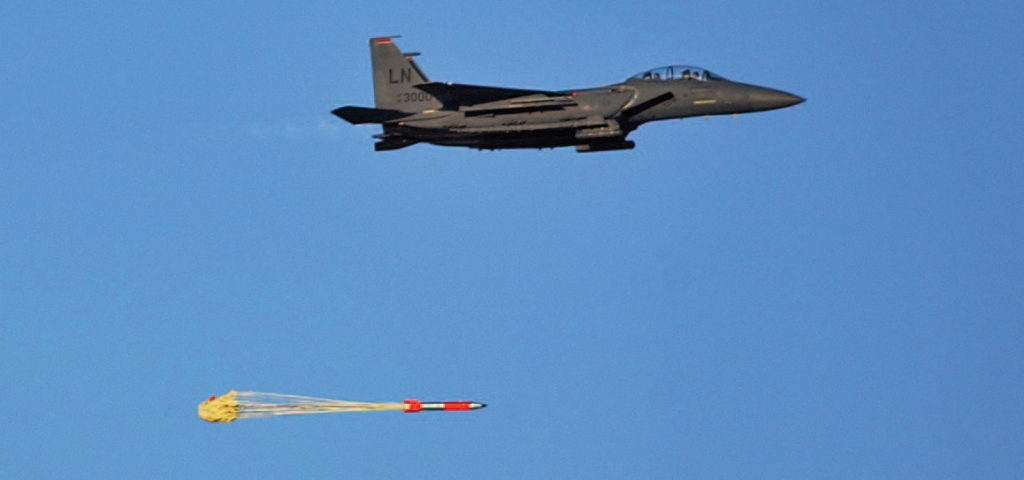
The Steadfast Noon exercise will practice employment of non-strategic nuclear weapons, like this unarmed B61-4 nuclear gravity bomb dropped by an F-15E from the 48th Fighter Wing at RAF Lakenheath. Image: Sandia National Laboratories.
[Updated version] Today, Monday October 17, 2022, the North Atlantic Treaty Organization (NATO) will begin a two-week long exercise in Europe to train aircrews in using U.S. non-strategic nuclear bombs. The exercise, known as Steadfast Noon, is centered at Kleine Brogel Air Base in Belgium, one of six airbases in Europe that store U.S. nuclear bombs. The exercise takes place midst significant modernizations at nuclear bases across Europe.
Steadfast Noon exercises are held once every year, but this year is unique because the exercise will take place during the largest conventional war in Europe since World War II with considerable tension and uncertainty resulting from Russia’s war in Ukraine. Moreover, Steadfast Noon is expected to more or less coincide with a large Russian strategic nuclear exercise. For NATO officials, other than Putin’s war in Ukraine, this is all routine. But for the public, it is but the latest development in rising tensions and unprecedented fears about nuclear war.
According to NATO, Steadfast Noon will involve 14 countries (less than half of the 30 NATO allies) and up to 60 aircraft. That involves fourth-generation F-16s and F-15Es as well as fifth-generation F-35A and F-22 fighter jets. A number of tankers and surveillance aircraft will also take part. Although the exercise is practicing NATO’s non-strategic nuclear forces, a couple of U.S. strategic B-52 bombers will also participate. Training flights will take place over Belgium and the United Kingdom as well as over the North Sea. There might also be flights over Germany and the Netherlands.
Practicing Nuclear Bomb Sharing
The Steadfast Noon exercise will practice a controversial arrangement known as nuclear sharing, under which the United States installs nuclear equipment on fighter jets of select non-nuclear NATO countries and train their pilots to carry out nuclear strike with U.S. nuclear bombs.
The arrangement is controversial because the United States as a party to the nuclear Non-Proliferation Treaty (NPT) has promised not to hand over nuclear weapons to other countries, and the non-nuclear countries in the sharing arrangement have promised not to receive nuclear weapons from the nuclear weapon states. In peacetime the nuclear weapons are under U.S. control, but the arrangement means that they would be handed over to the non-nuclear country in war time. The arrangement was in place before the NPT was signed so it is not a violation of the letter of the treaty. But it can be said to violate the spirit and has been an irritant for years.
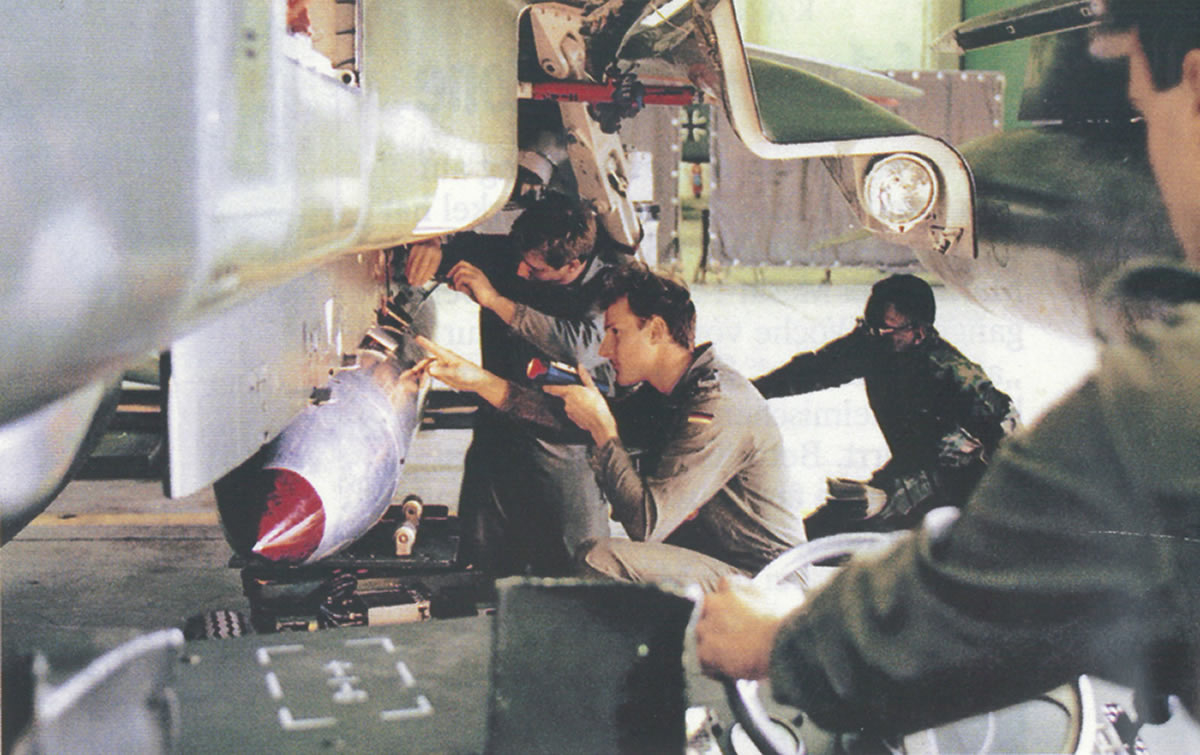
Under supervision by U.S. Air Force personnel, German Air Force personnel is practicing loading of a U.S. B61-4 nuclear bomb shape on a German Tornado fighter jet. In a war, German pilots could be given control of U.S. nuclear bombs. Image: Der Spiegel.
“If NATO was to conduct a nuclear mission in a conflict,” NATO says, “the B-61 [sic] weapons would be carried by certified Allied aircraft…However, a nuclear mission can only be undertaken after explicit political approval is given by NATO’s Nuclear Planning Group (NPG) and authorisation is received from the US President and UK Prime Minister.” It is unclear why the U.K. Prime Minister would have to authorize employment of U.S. nuclear weapons, and unless NATO territory had been attacked with nuclear weapons first, it seems unlikely that the 29 countries in the NPG would be able to agree to approve of employment of non-strategic nuclear weapons from bases in Europe.
NATO disclosed earlier this year that seven NATO countries contribute dual-capable aircraft to the nuclear sharing mission. The countries were not identified but five are widely known: Belgium, Germany, Italy, Netherlands, and the United States. The sixth country is probably Turkey (despite rumors that it was no longer part of the mission), in which case some Turkish F-16s are still equipped to deliver B61 bombs. The seventh country was a mystery, but it turns out it is Greece. Although Greece no longer stores nuclear weapons (they were withdrawn in 2001) and doesn’t have a committed fighter unit, it has a reserve units and a contingency mission. Like other allies (except France), Greece is fully involved in the NPG.]
Nuclear Base Modernizations
During the past several years, the nuclear bases and the infrastructure that support the nuclear sharing mission in Europe have been undergoing significant upgrades, including cables, command and control systems, weapons maintenance and custodial facilities, security perimeters, and runway and tarmac areas.
There are currently six active sites in Europe that store U.S. nuclear bombs: Kleine Brogel air base in Belgium, Büchel air base in Germany, Aviano and Ghedi air bases in Italy, Volkel air base in the Netherlands, and possibly Incirlik in Turkey. The estimated number of weapons at each site is based on the number of active vaults, aircraft, and other information.
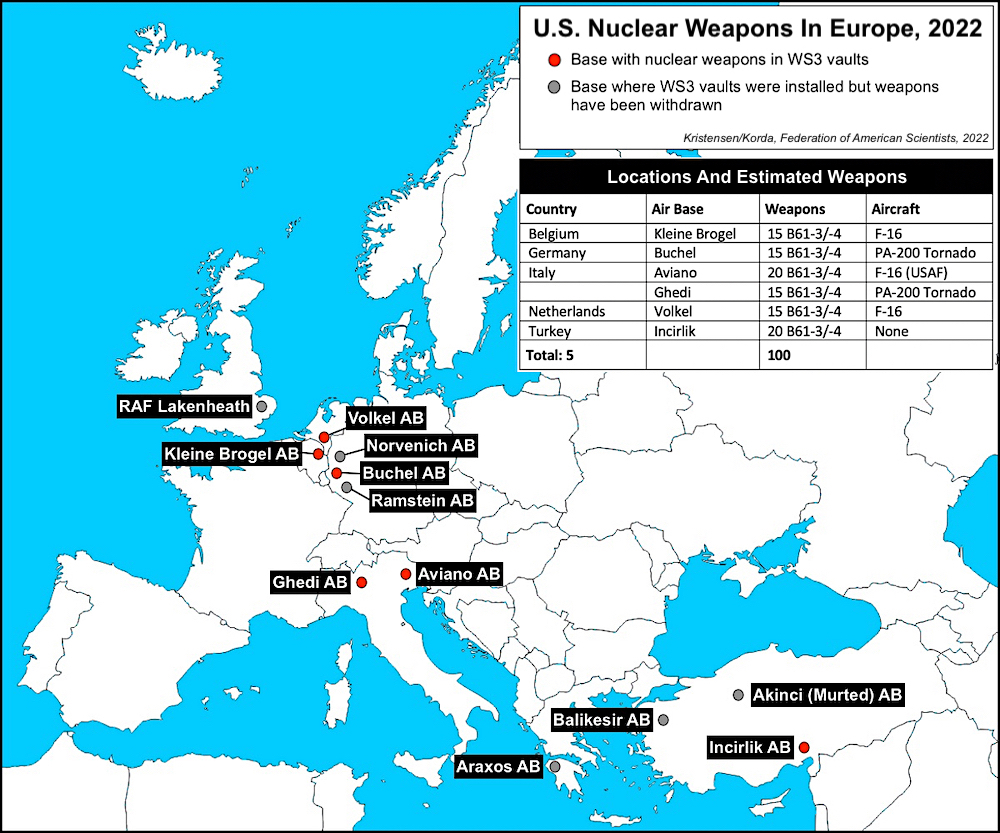
Each of these bases have one or two dozen active vaults (Weapons Storage Security System, WS3) inside as many protective aircraft shelters. Ramstein air base in Germany used to be the largest storage site in Europe but only 7 vaults remain active possibly for training and transfer. All weapons were withdrawn from Lakenheath before 2007 but the United Kingdom was recently added to the nuclear infrastructure storage modernization program, which means there are now eight active WS3 sites in Europe.

The modernizations at the various bases vary depending on capacity, location, and host country. At Kleine Brogel Air Base in Belgium, the host base for the Steadfast Noon exercise this year, the 701st Munition Support Squadron quarters have been significantly expanded with a drive-through facility for nuclear weapons maintenance trucks. Other construction includes a major facility inside the aircraft tarmac perimeter area, a new control tower, and upgrades of underground cables and the Alarm Communication & Display (AC&D) system.
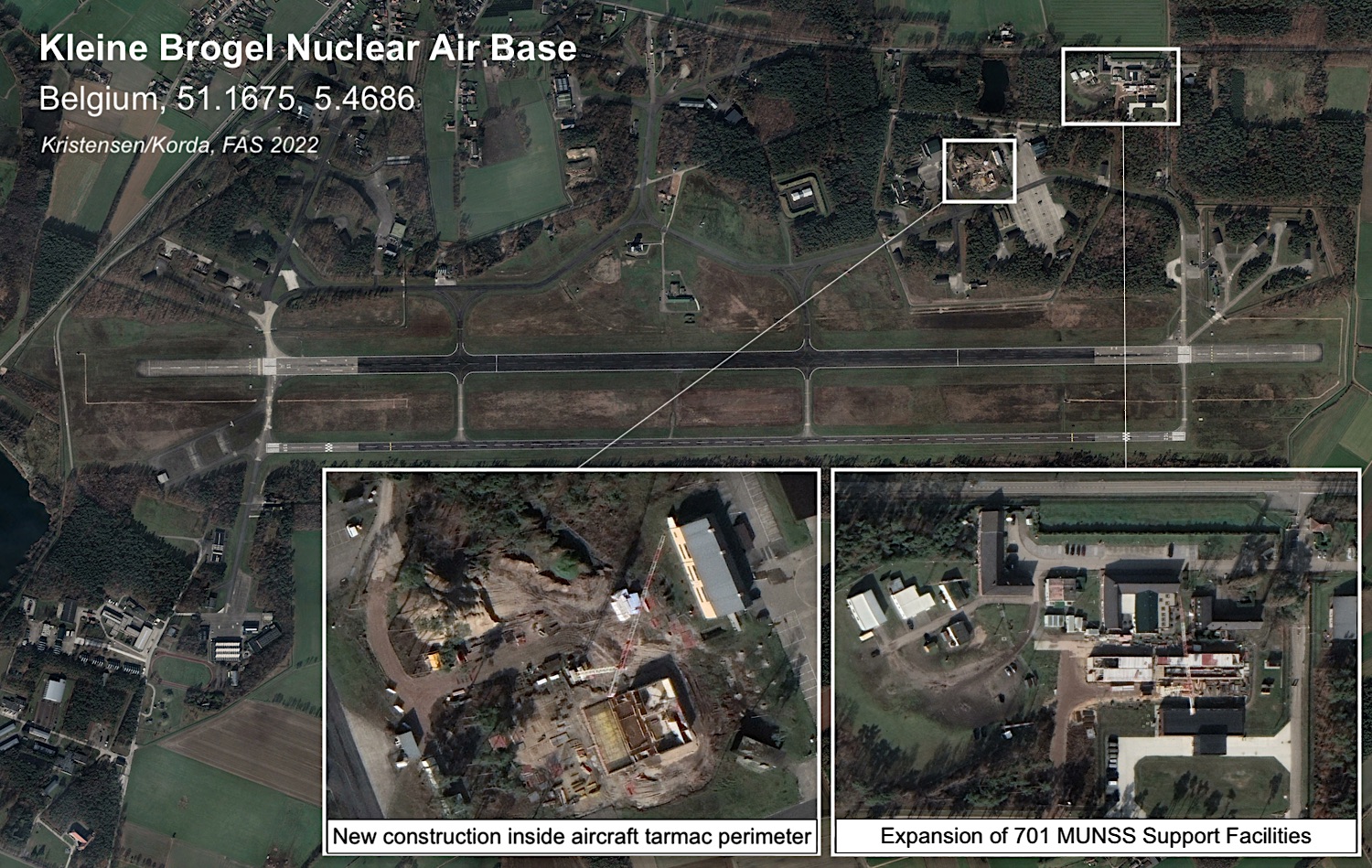
At Büchel Air Base in Germany, construction is underway on the runway. During construction, the Tornados of the 33rd Fighter Wing will be temporarily based at Norvenich Air Base. However, the 10-15 B61 nuclear bombs will remain in the vaults at Büchel. Other recent updates at the base have included underground cables and the Alarm Communication & Display (AC&D) system.
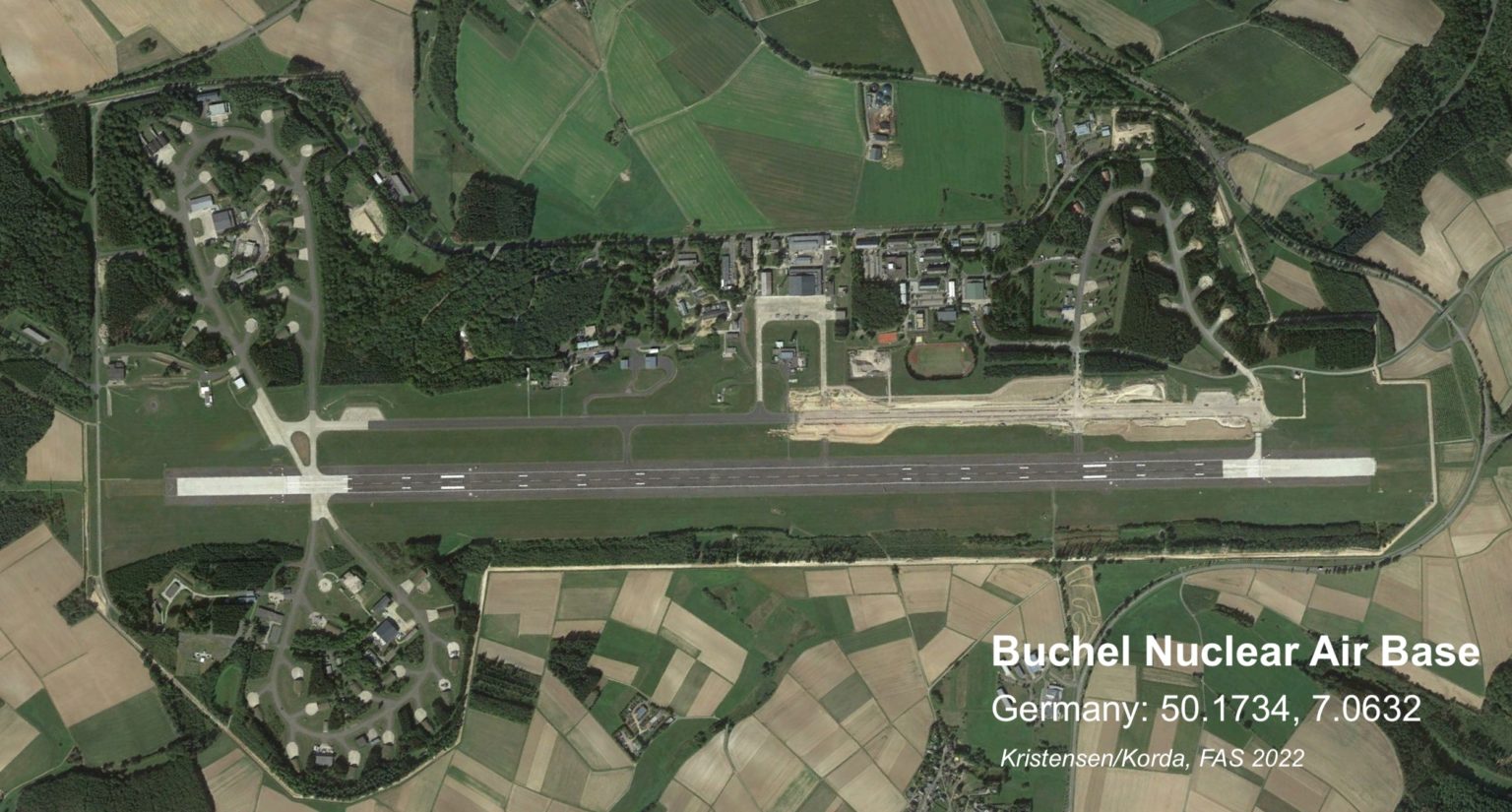
In 2020, as part of a series of visits to bases involved in the nuclear sharing mission, U.S. Air Force Maj. Gen. Derek C. France, the director of operations, strategic deterrence, and integration for U.S. Air Forces in Europe – Air Forces Africa Headquarters director of operations, strategic deterrence, and integration, visited Büchel Air Base where he received a tour and explanation of a protective aircraft shelter. A picture of the tour shows the vault open and a B61 nuclear bomb shape inside.
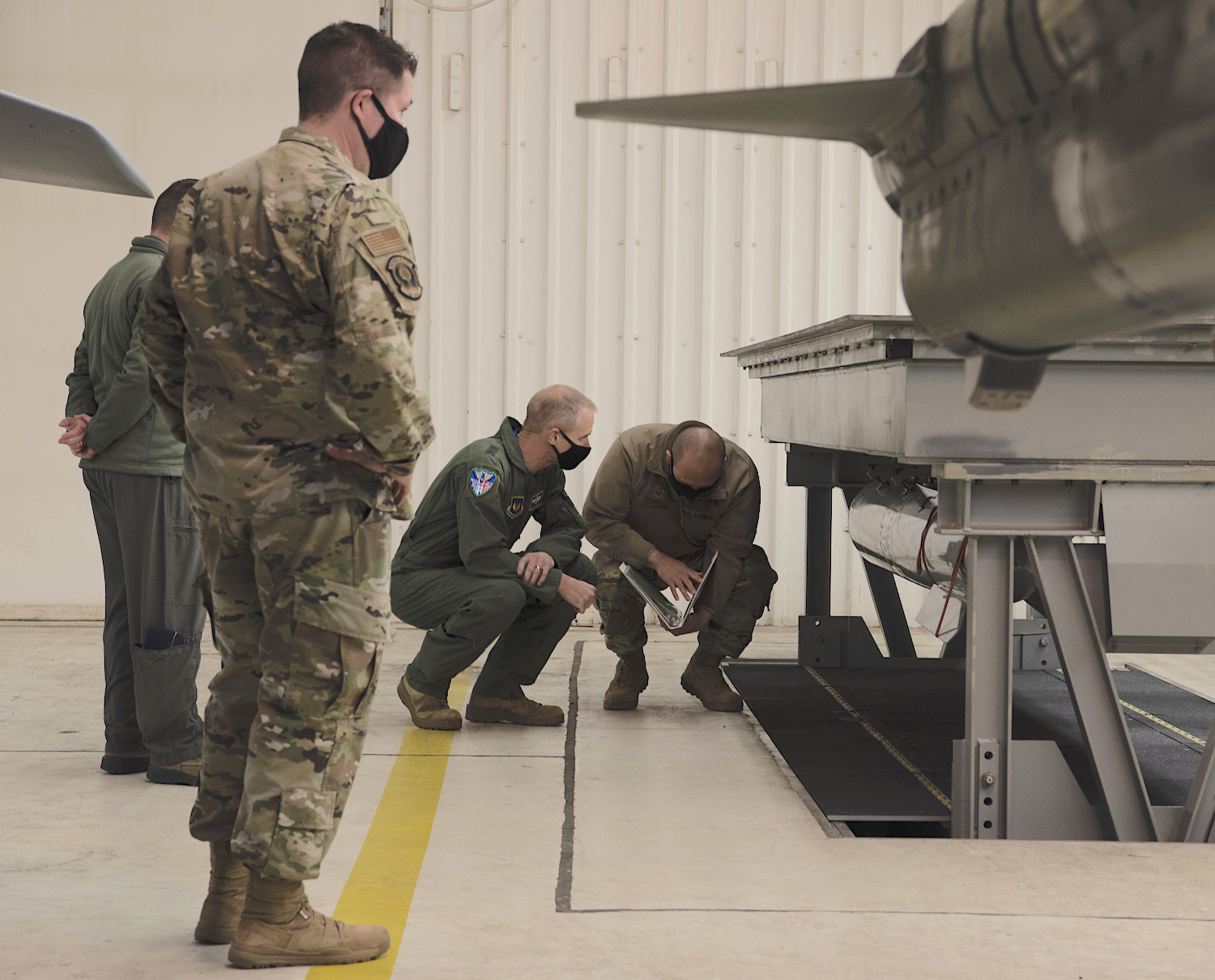
U.S. Air Force Maj. Gen. Derek C. France, U.S. Air Forces in Europe – Air Forces Africa Headquarters director of operations, strategic deterrence, and nuclear integration, received a tour of a Protective Aircraft Shelter at Büchel Air Base on October 15, 2020. The image shows a B61 nuclear bomb shape hanging in the elevated vault.
At Volkel Air Base in the Netherlands, the most visible modernization currently underway is a major new tarmac area. The construction includes security perimeters probably intended to protect the C-17 aircraft that transport weapons and components to and from the base. Other recent construction the base has included burying underground cables and upgrading the Alarm Communication & Display (AC&D) system used for the WS3 vaults.
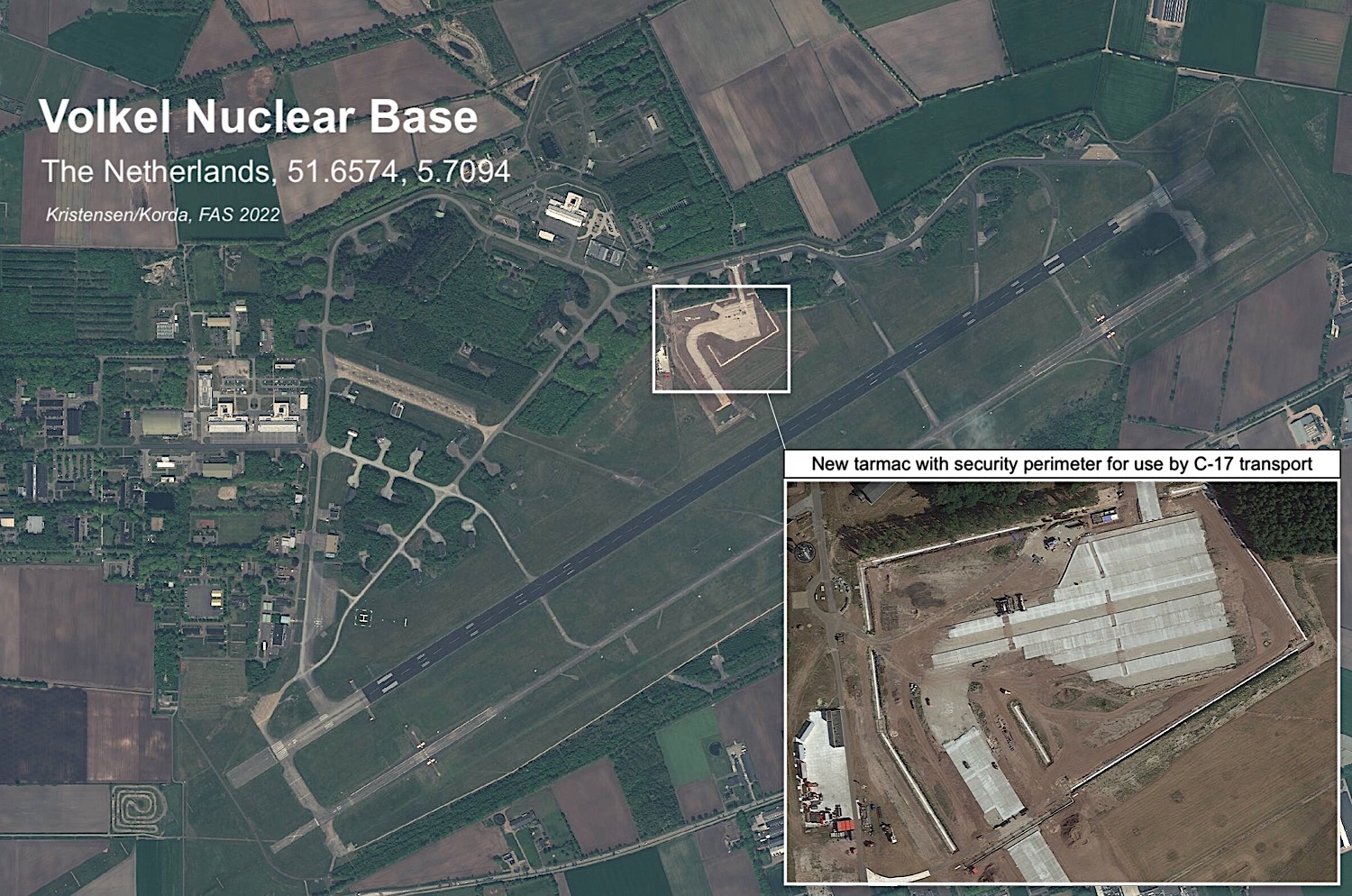
Ghedi Air Base in Italy is undergoing a dramatic upgrade that includes a new tarmac and shelter area for the new F-35A fighter jets that will replace the Tornado jets in the nuclear sharing mission. Work is also underway on what appears to be a drive-through facility for weapons maintenance trucks in the 704th MUNSS area. And a new high-security perimeter has been erected around eight vaults, possibly those of the 11 that are active. This perimeter is similar to perimeters that were constructed at Aviano and Incirlik air bases in 2014-2015. Finally, Ghedi also has received an upgrade of underground cables and the Alarm Communication & Display (AC&D) system used for the WS3 vaults.
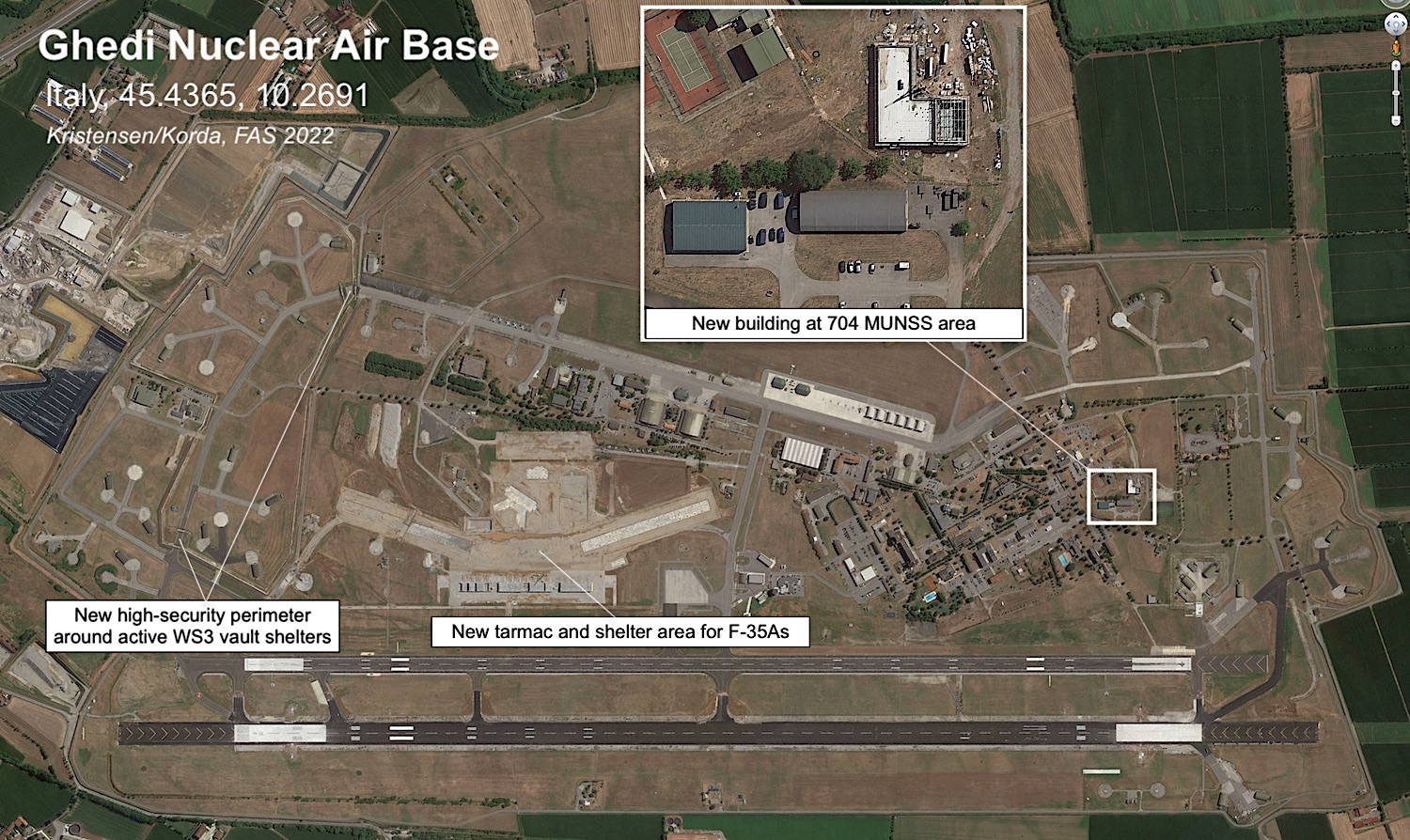
Upgrades of Aviano Air Base in Italy and Incirlik Air Base in Turkey happened around 2015 are described in this article: Upgrades At US Nuclear Bases In Europe Acknowledge Security Risk. Since then, installation of new cables between the nuclear vaults at Incirlik Air Base is visible on satellite images.

Weapons Modernization
In addition to modernization of bases and support facilities, delivery systems and weapons are also being upgraded. Five of the seven countries that contribute dual-capable aircraft to the nuclear sharing mission are upgrading to the F-35A fifth-generation fighter-bomber: Belgium, Germany, Italy, the Netherlands, and the United States. Turkey was scheduled to upgrade to F-35A but lost the contract after it purchased the Russian S-400 system.
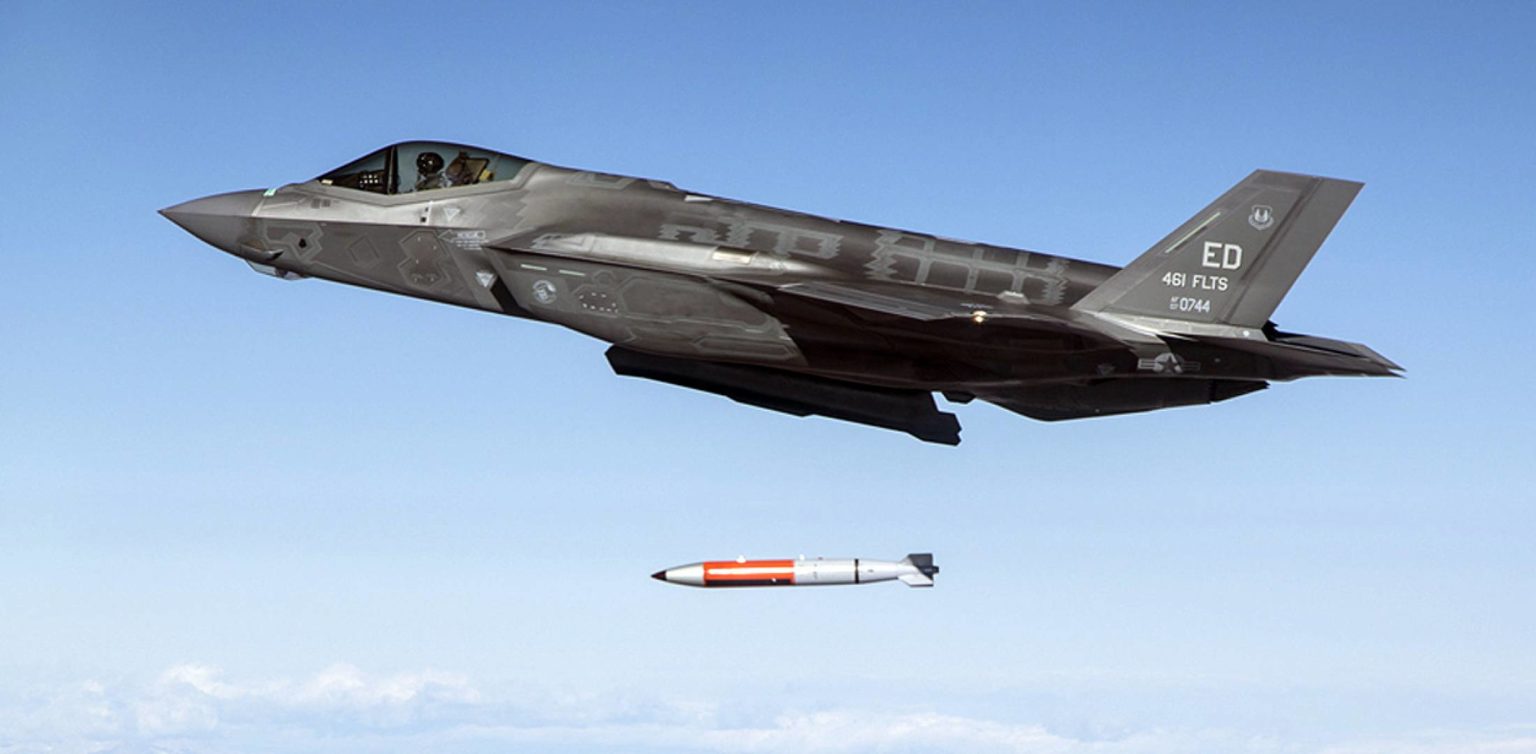
An F-35A test-drops a B61-12 guided nuclear bomb. The enhanced weapon will be compatible with both fighter jets and strategic bombers and begin replacing older B61 versions in Europe from 2023. Image: U.S. Air Force.
Finally, the existing B61 nuclear bombs will soon be replaced by the enhanced B61-12 guided nuclear bomb. Development is essentially complete and full-scale production of about 480 B61-12s is expected to begin soon. The new weapon is thought to have the same yield range as the current B61-4: 0.3, 1.5, 10 and 50 kilotons. Training of the units in Europe to receive the new weapon is scheduled to begin in early-2023 and the first weapons potentially arriving at the first base in late-2023 or 2024.
In addition to the non-strategic fighter jets F-15E, F-16, F-35A, and Tornado, the B61-12 will also be integrated on the B-2 and B-21 strategic bombers. Because of the increased accuracy provided by the tail kit, all the digital aircraft that can make use of it (all except F-16 and Tornado) will be able to hold at risk a wide range of targets. The combination of increased accuracy and lower-yield options on non-strategic and strategic stealth aircraft will significantly increase the capability of the gravity bomb mission.

Each of the WS3 vaults at European bases can hold up to four nuclear bombs. Here crews are practicing loading B61 bombs into a vault: two B61-3/4 bombs on the top rack and two B61-12 bombs on the lower rack. Image: U.S. Air Force, obtained by Joseph Trevithick (The Drive) under FOIA.
This publication was made possible by generous contributions from the John D. and Catherine T. MacArthur Foundation, the New-Land Foundation, the Ploughshares Fund, the Prospect Hill Foundation, Longview Philanthropy, the Stewart R. Mott Foundation, the Future of Life Institute, Open Philanthropy, and individual donors. The statements made and views expressed are solely the responsibility of the author.
New Environmental Assessment Reveals Fascinating Alternatives to Land-Based ICBMs
A new Air Force environmental assessment reveals that it considered basing ICBMs in underground railway tunnels––or possibly underwater.

Map of the ICBM missile fields contained within the Air Force’s July 2022 assessment.
On July 1st, the Air Force published its Draft Environmental Impact Statement (EIS) for its proposed ICBM replacement program, previously known as the Ground-Based Strategic Deterrent (GBSD) and now by its new name, “Sentinel.” The government typically conducts an EIS whenever a federal program could potentially disrupt local water supplies, transportation, socioeconomics, geology, air quality, and other related factors.
A comprehensive environmental assessment is certainly warranted in this case, given the tremendous scale of the Sentinel program––which consists of a like-for-like replacement of all 400 Minuteman III missiles that are currently deployed across Colorado, Montana, Nebraska, North Dakota, and Wyoming, plus upgrades to the launch facilities, launch control centers, and other supporting infrastructure.

Cover page of the Air Force’s July 2022 Draft Environmental Impact Statement for the GBSD.
The Draft EIS was anxiously awaited by local stakeholders, chambers of commerce, contractors, residents, and… me! Not because I’m losing sleep about whether Sentinel construction will disturb Wyoming’s Western Bumble Bee (although maybe I should be!), but rather because an EIS is also a wonderful repository for juicy, and often new, details about federal programs––and the Sentinel’s Draft EIS is certainly no exception.
Interestingly, the most exciting new details are not necessarily about what the Air Force is currently planning for the Sentinel, but rather about which ICBM replacement options they previously considered as alternatives to the current program of record. These alternatives were assessed during in the Air Force’s 2014 Analysis of Alternatives––a key document that weighs the risks and benefits of each proposed action––however, that document remains classified. Therefore, until they were recently referenced in the July 2022 Draft EIS, it was not clear to the public what the Air Force was actually assessing as alternatives to the current Sentinel program.
Missile alternatives
The Draft EIS notes that the Air Force assessed four potential missile alternatives to the current plan, which involves designing a completely new ICBM:
- Reproducing Minuteman III ICBMs to “existing specifications” by washing out and refilling the first- and second-stage rocket boosters; remanufacturing the third stages and Propulsion System Rocket Engine––the ICBM’s post-boost vehicle; and refurbishing and replacing all other subsystems;
The Air Force appears to have ultimately eliminated all four of these options from consideration because they did not meet all of their “selection standards,” which included criteria like sustainability, performance, safety, riskiness, and capacity for integration into existing or proposed infrastructure.
Of particular interest, however, is the Air Force’s note that the Minuteman III reproduction alternative was eliminated in part because it did not “meet the required performance criteria for ICBMs in the context of modern and evolving threats (e.g., range, payload, and effectiveness.” It is highly significant to state that the Minuteman III cannot meet the required performance criteria for ICBMs, given that the Minuteman III currently performs the ICBM role for the US Air Force and will continue to do so for the next decade.
This statement also suggests that “modern and evolving threats” are driving the need for an operationally improved ICBM; however, it is unclear what the Air Force is referring to, or how these threats would necessarily justify a brand-new ICBM with new capabilities. As I wrote in my March 2021 report, “Siloed Thinking: A Closer Look at the Ground-Based Strategic Deterrent,”
“With respect to US-centric nuclear deterrence, what has changed since the end of the Cold War? China is slowly but steadily expanding its nuclear arsenal and suite of delivery systems, and North Korea’s nuclear weapons program continues to mature. However, the range and deployment locations of the US ICBM force would force the missiles to fly over Russian territory in the event that they were aimed at Chinese or North Korean targets, thus significantly increasing the risk of using ICBMs to target either country. Moreover, […] other elements of the US nuclear force––especially SSBNs––could be used to accomplish the ICBM force’s mission under a revised nuclear force posture, potentially even faster and in a more flexible manner. […] It is additionally important to note that even if adversarial missile defenses improved significantly, the ability to evade missile defenses lies with the payload––not the missile itself. By the time that an adversary’s interceptor was able to engage a US ICBM in its midcourse phase of flight, the ICBM would have already shed its boosters, deployed its penetration aids, and would be guided solely by its reentry vehicle. Reentry vehicles and missile boosters can be independently upgraded as necessary, meaning that any concerns about adversarial missile defenses could be mitigated by deploying a more advanced payload on a life-extended Minuteman III ICBM.”
Of additional interest is the passage explaining why the Air Force dismissed the possibility of using the Trident II D5 SLBM as a land-based weapon:
“The D5 is a high-accuracy weapon system capable of engaging many targets simultaneously with overall functionality approaching that of land- based missiles. The D5 represents an existing technology, and substantial design and development cost savings would be realized; but the associated savings would not appreciably offset the infrastructure investment requirements (road and bridge enhancements) necessary to make it a land-based weapon system. In addition, motor performance and explosive safety concerns undermine the feasibility of using the D5 as a land-based weapon system.”
The Air Force’s concerns over road and bridge quality are probably justified––missiles are incredibly heavy, and America’s bridges are falling apart at a terrifying rate. However, it is unclear why the Air Force is not confident about the D5’s motor performance, given that even aging Trident SLBMs have performed very well in recent flight tests: in 2015 the Navy conducted a successful Trident flight test using “the oldest 1st stage solid rocket motor flown to date” (over 26 years old), with 2nd and 3rd stage motors that were 22 years old. In January 2021, Vice Admiral Johnny Wolfe Jr.––the Navy’s Director for Strategic Systems Programs––remarked that “solid rocket motors, the age of those we can extend quite a while, we understand that very well.” This is largely due to the Navy’s incorporation of nondestructive testing techniques––which involve sending a probe into the bore to measure the elasticity of the propellant––to evaluate the reliability of their missiles.
As a result, the Navy is not currently contemplating the purchase of a brand-new missile to replace its current arsenal of Trident SLBMs, and instead plans to conduct a second life-extension to keep them in service until 2084. However, the Air Force’s comments suggest either a lack of confidence in this approach, or perhaps an institutional preference towards developing an entirely new missile system. [Note: Amy Woolf helpfully offered up another possible explanation, that the Air Force’s concerns could be related to the ability of the Trident SLBM’s cold launch system to perform effectively on land, given that these very different launch conditions could place additional stress on the missile system itself.]
Basing alternatives
The Draft EIS also notes that the Air Force assessed two fascinating––and somewhat familiar––alternatives for basing the new missiles: in underground tunnels and in “deep-lake silos.”
The tunnel option––which had been teased in previous programmatic documents but never explained in detail––would include “locating, designing, excavating, developing, and installing critical support infrastructure such as rail systems and [launch facilities] for an array of underground tunnels that would likely span hundreds of miles”––and it is effectively a mashup of two concepts from the late Cold War.
The rail concept was strongly considered during the development of the MX missile in the 1980s, although the plan called for missile trains to be dispersed onto the country’s existing civilian rail network, rather than into newly-built underground tunnels. Both the rail and tunnel concepts were referenced in one of my favourite Pentagon reports––a December 1980 Pentagon study called “ICBM Basing Options,” which considered 30 distinct and often bizarre ICBM basing options, including dirigibles, barges, seaplanes, and even hovercraft!

Illustrations of “Commercial Rail” concept from 1980 Pentagon report, “ICBM Basing Options.”
The second option––basing ICBMs in deep-lake silos––was also referenced in that same December 1980 study. The concept––nicknamed “Hydra”––proposed dispersing missiles across the ocean using floating silos, with “only an inconspicuous part of the missile front end [being] visible above the surface.” Interestingly, this raises the theoretical question of whether the Air Force would still maintain control over the ICBM mission, given that the missiles would be underwater.

Illustration of “Hydra” concept from 1980 Pentagon report, “ICBM Basing Options.”
When considering alternative basing modes for the Sentinel ICBM, the Air Force eliminated both concepts due to cost prohibitions, and, in the case of underwater basing, a lack of confidence that the missiles would be safe and secure. This concern was also floated in the 1980 study as well, with the Pentagon acknowledging the likelihood that US adversaries and non-state actors “would also be engaged in a hunt for the Hydras. Not under our direct control, any missile can be destroyed or towed away (stolen) at leisure.”
Another potential option?
In addition to revealing these fascinating details about previously considered alternatives to the Sentinel program, the Draft EIS also highlighted a public comment suggesting that “the most environmentally responsible option” would simply be the reduction of the Minuteman III inventory.
The Air Force rejected the comment because it says that it is “required by law to accelerate the development, procurement, and fielding of the ground based strategic deterrent program;’” however, the public commenter’s suggestion is certainly a reasonable one. The current force level of 400 deployed ICBMs is not––and has never been––a magic number, and it could be reduced further for a variety of reasons, including those related to security, economics, or a good faith effort to reduce deployed US nuclear forces. In particular, as George Perkovich and Pranay Vaddi wrote in a 2021 Carnegie Endowment for International Peace report, “This assumption that the ICBM force would not be eliminated or reduced before 2075 is difficult to reconcile with U.S. disarmament obligations under Article VI of the Nuclear Non-Proliferation Treaty.”
The security environment of the 21st century is already very different than that of the previous century. The greatest threats to Americans’ collective safety are non-militarized, global phenomena like climate change, domestic unrest and inequality, and public health crises. And recent polling efforts by ReThink Media, the Union of Concerned Scientists, and the Federation of American Scientists suggest that Americans overwhelmingly want the government to invest in more proximate social issues, rather than on nuclear weapons. To that end, rather than considering building new missile tunnels, it would likely be much more domestically popular to spend money on domestic priorities––perhaps new subway tunnels?
—
Background Information:
- “Siloed Thinking: A Closer Look at the Ground-Based Strategic Deterrent,” Federation of American Scientists (Mar. 2021)
- “Environmental Assessment Reveals New Details About the Air Force’s ICBM Replacement Plan,” Federation of American Scientists (Nov. 2020)
- ICBM Information Project, Federation of American Scientists
This publication was made possible by generous support from the John D. and Catherine T. MacArthur Foundation, the New-Land Foundation, Ploughshares Fund, the Prospect Hill Foundation, and Longview Philanthropy. The statements made and views expressed are solely the responsibility of the author.
Lakenheath Air Base Added To Nuclear Weapons Storage Site Upgrades
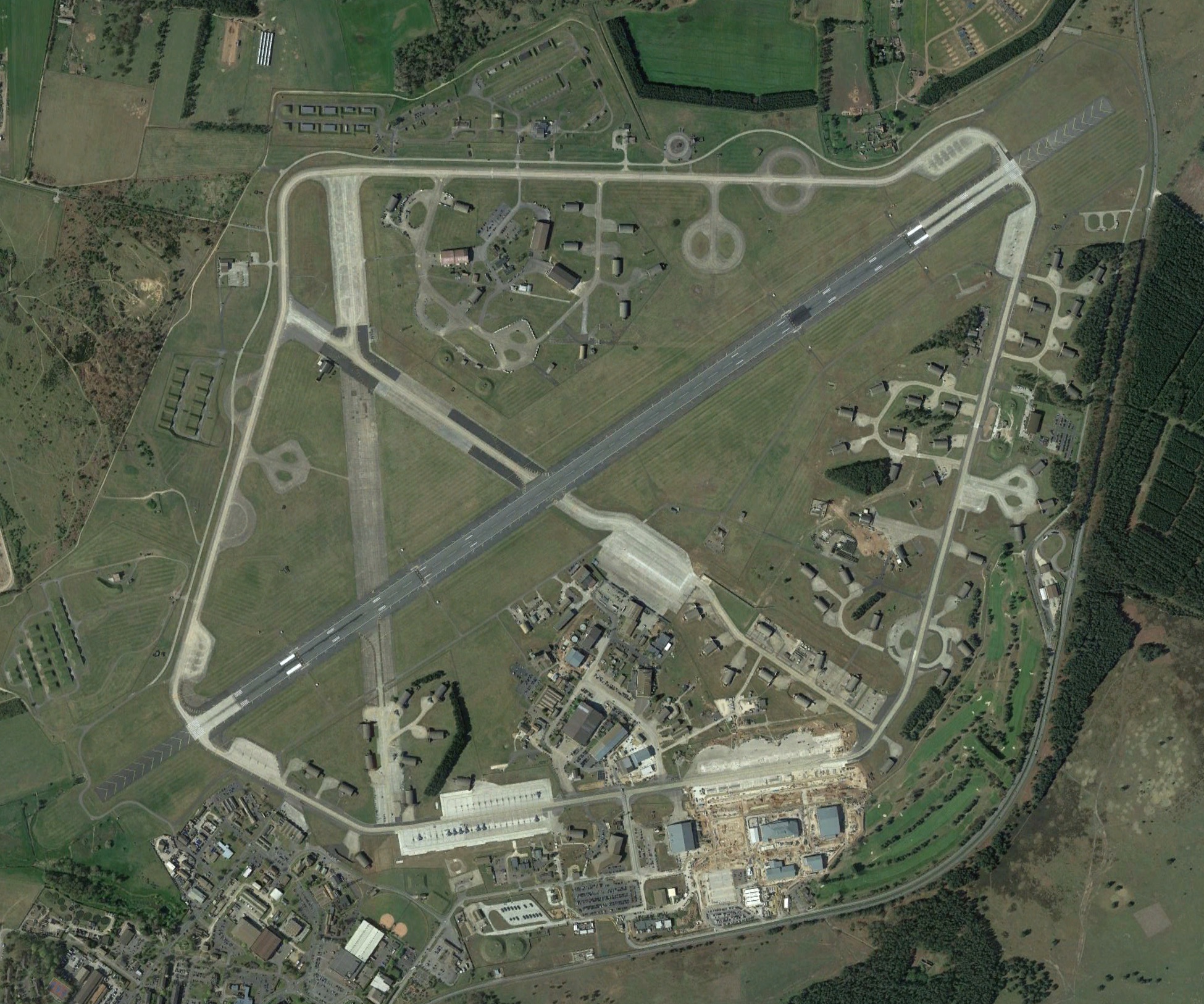
The US Air Force base at Lakenheath has been added to the list of nuclear weapons storage sites being upgraded in Europe.
US Defense Department documents show that NATO has quietly added the United Kingdom to the list of nuclear weapons storage locations that are being upgraded.
The documents do not identify the specific facility, but it is believed to be the US Air Base at RAF Lakenheath in southeast England approximately 100 kilometers northeast of London.
Previous budget documents listed “special weapons” storage sites in Belgium, Germany, Italy, the Netherlands, and Turkey as receiving upgrades under a 13-year NATO investment program. The Biden administration’s FY2023 defense budget request adds “the UK” to the list (see image below).
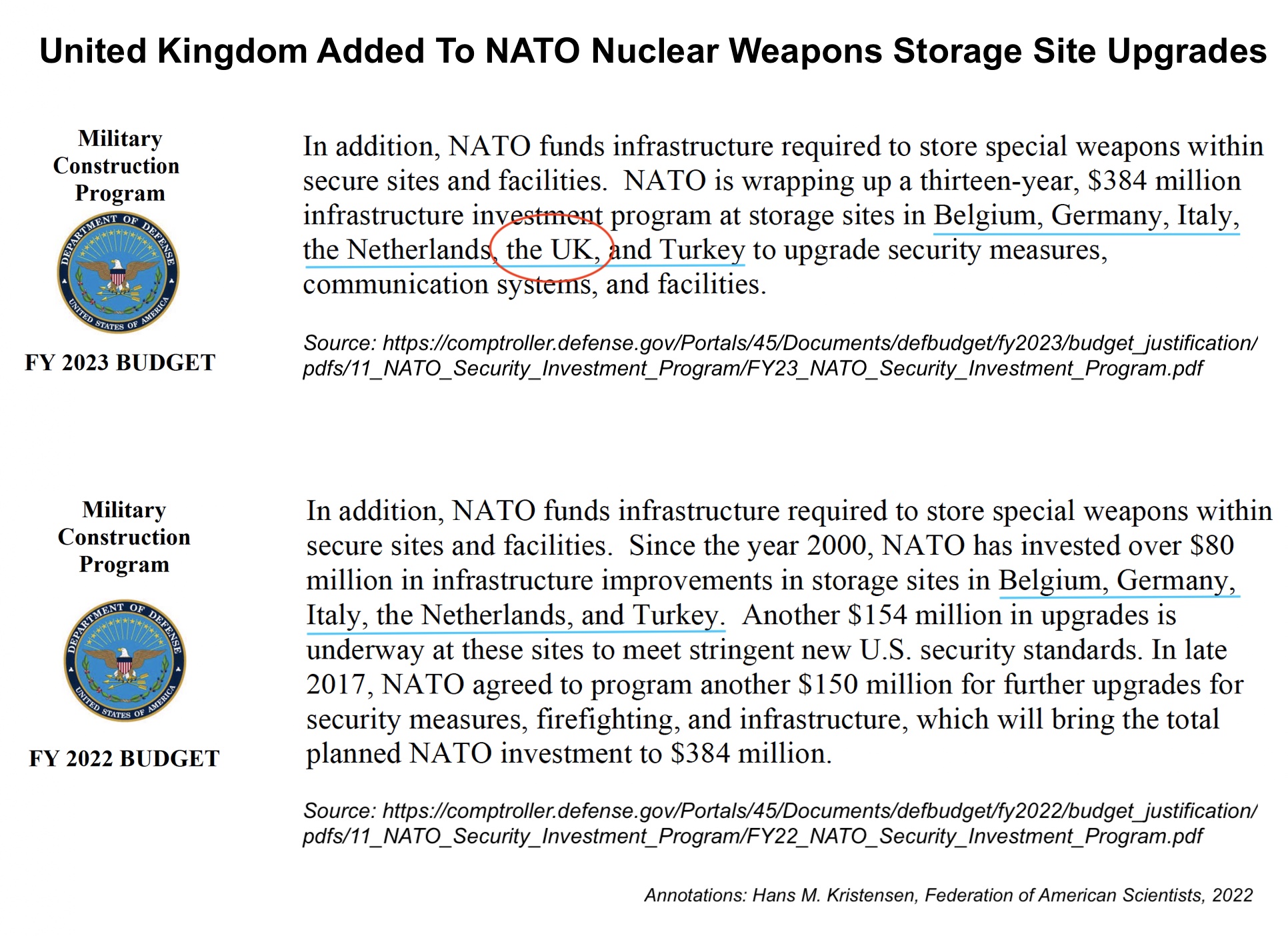
The United Kingdom has been added to the list of nuclear weapons storage site locations in Europe. Click on image to view full size.
RAF Lakenheath was not on the list of “active sites” in the 2016 contract for the upgrade of the nuclear weapons storage site in Europe. The budget documents indicate the base has since been added to the list.
The US Air Force used to store nuclear gravity bombs at Lakenheath, which in the 1990s was equipped with 33 underground storage vaults. By the early 2000s, there were a total of 110 B61 gravity bombs in the vaults for delivery by F-15E aircraft of the 48th Fighter Wing.
In 2008, I disclosed that the nuclear weapons had been withdrawn from RAF Lakenheath, the first time since 1954 that the United States did not store nuclear weapons in the United Kingdom.
What’s Going On?
The addition of the United Kingdom to the list of nuclear storage locations being upgraded in Europe signals a change in the nuclear status of RAF Lakenheath. It is unclear if nuclear weapons have been returned to the base yet or NATO is upgrading the base to be capable of receiving nuclear weapons in the future if necessary.
After nuclear weapons were withdrawn nearly two decades ago, the empty storage vaults were kept in caretaker status. The F-15Es fighter-bombers retained their nuclear capability but at a lower operational level. In recent years there have been rumors about nuclear exercises at the base.
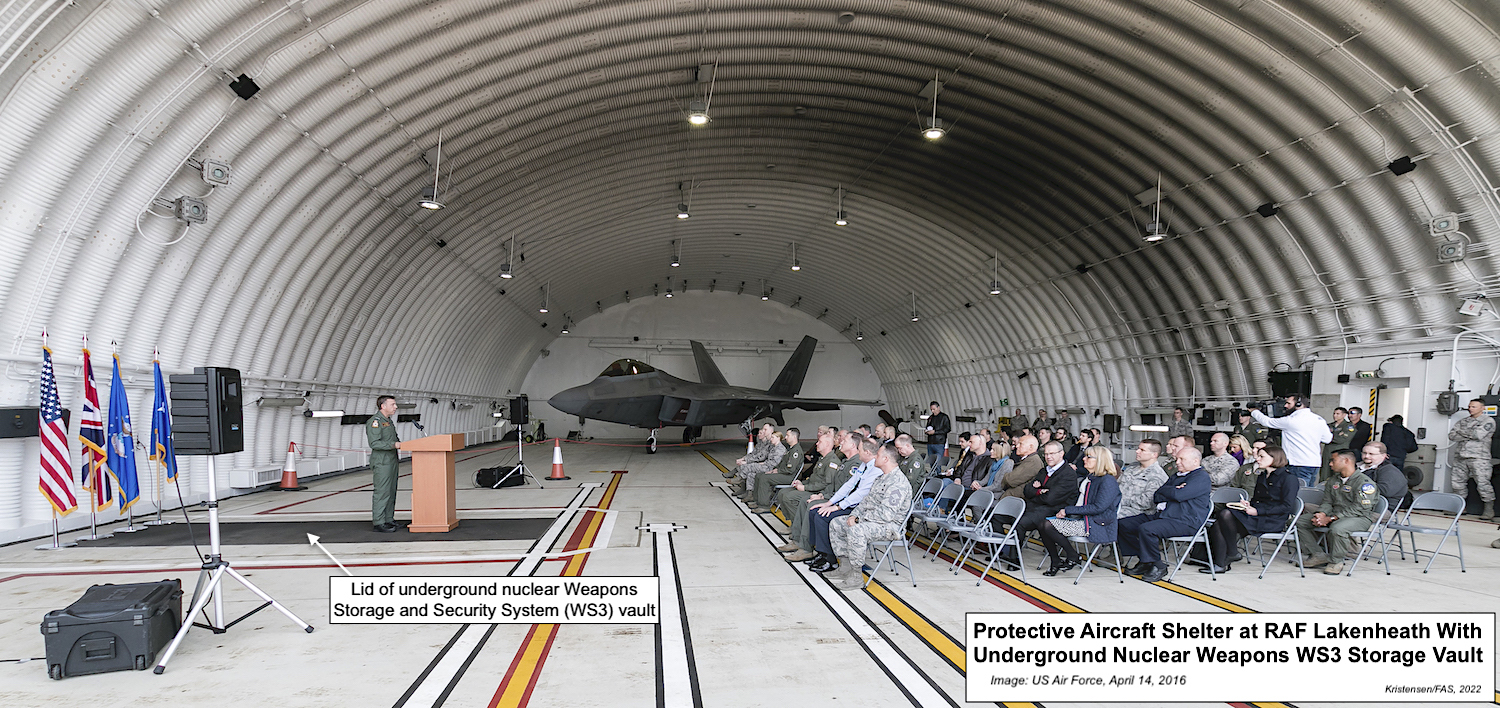
A ceremony during a F-22 Raptor visit to RAF Lakenheath in 2016 was held inside an aircraft shelter with an (empty) underground nuclear weapons vault. There are 33 vaults at the base.
The nuclear upgrade comes as RAF Lakenheath is preparing to become the first US Air Force base in Europe equipped with the nuclear-capable F-35A Lightning. The first of the fifth-generation fighter-bombers arrived in December 2021. A total of 24 F-35As will form the 495th Fighter Squadron of the 48th Fighter Wing at the base.
The US Air Force is scheduled to begin training the nuclear units in Europe within the next year to receive the new B61-12 guided nuclear bomb that will begin full-scale production next month. It is possible the first B61-12 bombs will be shipped to Europe in 2023, where they will replace the B61-3/-4 bombs currently deployed there.

The US will begin full-scale production of the new B61-12 guided nuclear bomb next month, start training units in Europe around the turn of the year, and potentially deploy the first weapons in 2023.
Given NATO’s cautious nuclear response to Russia’s nuclear saber rattling at the start of its invasion of Ukraine, it would be odd if the nuclear upgrade at RAF Lakenheath reflected plans to deploy additional US nuclear bombs to Europe. FAS estimates there currently are roughly 100 nuclear bombs deployed at six air bases in five European countries.
NATO Secretary General Jens Stoltenberg declared in December 2021, that “we have no plans of stationing any nuclear weapons in any other countries than we already have these nuclear weapons as part of our deterrence and that… have been there for many, many years.” Unless NATO has changed its plans since, that seems to be a clear signal that there are currently no plans to deploy nuclear weapons to RAF Lakenheath for now (see map below).

RAF Lakenheath has been an inactive nuclear weapons storage site for nearly two decades. There are currently an estimated 100 US Air Force nuclear bombs stored in Europe.
Rather, the upgrade at RAF Lakenheath could potentially be intended to increase the flexibility of the existing nuclear deployment within Europe, without increasing the number of weapons. Adding RAF Lakenheath as an active site would potentially allow it to receive nuclear weapons from other existing locations in Europe, if that became necessary. Such a contingency could potentially involve receiving weapons withdrawn from Turkey. There are unconfirmed rumors that many of the weapons at Incirlik Air Base in Turkey have already been withdrawn and moved to other bases in Europe.
Readying RAF Lakenheath could potentially also be intended to better realign the overall nuclear posture in Europe with the rapidly deteriorating relations with Russia. This is a delicate issue because changes in NATO’s nuclear posture in Europe might trigger retaliatory changes in Russia’s nuclear posture, including potentially deployment of nuclear weapons to Belarus, which recently changed its constitution to allow for just that.
This publication was made possible by generous support from the John D. and Catherine T. MacArthur Foundation, the New Land Foundation, the Ploughshares Fund, and the Prospect Hill Foundation. The statements made and views expressed are solely the responsibility of the author.
Amidst Nuclear Saber Rattling, New START Treaty Demonstrates Importance
Shortly after Russian military forces invaded Ukraine and President Vladimir Putin said that he had ordered Russian nuclear forces on high combat alert – apparently to deter the United States from getting directly involved, and the United States condemned the statement as “unacceptable” nuclear saber rattling but refused to respond in kind, the two vehemently opposed countries did something amazing: They exchanged factual information about the status of their strategic nuclear forces as required under the New START Treaty.
Yesterday, the US State Department published the unclassified bits of that data exchange. It shows that both countries were below the limits set by the treaty for deployed strategic nuclear forces: 1,550 warheads attributed to 700 deployed long-range ballistic missiles and heavy bombers.
At a time when direct contacts are being curtailed, antagonism runs high, and trust completely lost, it is nothing short of amazing that Russia and the United States continue to abide by the New START treaty and exchange classified information as if nothing had happened.
The reason is clear. Despite their differences, they both have a keen interest in keeping the other country’s long-range nuclear forces in check.
Both the United States and Russia have far more nuclear warheads in their total military stockpiles than what they deploy on their launchers under New START. If the treaty fell away, each side could dramatically and quickly increase the number of nuclear warheads ready to launch on short notice. The US has close to 2,000 strategic warheads in storage, Russia about half that many. Such an increase would be extraordinarily destabilizing and dangerous, especially with a full-scale war raging in Europe and Russia buckling under the strain of unprecedented sanctions.
What the Data Shows

The latest set of data shows that as of March 1, 2022, the United States and Russia both were in compliance with their obligations under the New START treaty not to operate more than 800 total strategic launchers, no more than 700 deployed strategic launchers, and no more than 1,550 warheads attributed to those deployed launchers.
Combined the two countries possessed a total of 1,561 accountable strategic missiles and heavy bombers, of which 1,212 launchers were deployed with 2,989 attributable warheads. That is a slight increase in the number of deployed launchers and warheads compared with six months ago (note: the combined warhead number is actually about 100 too high because each deployed bomber is counted as one weapon even though neither country’s bombers carry weapons under normal circumstances).
Compared with September 2021, the data shows the two countries combined increased the total number of strategic launchers by 19, increased combined deployed strategic launchers by 20, and increased the combined deployed strategic warheads by 142. Of these numbers, only the “19” is real; the other changes reflect natural fluctuations as launchers move in and out of maintenance or are being upgraded.
In terms of the total effect of the treaty, the data shows the two countries since February 2011 combined have cut 428 strategic launchers from their arsenals, reduced deployed strategic launchers by 191, and reduced the number of deployed strategic warheads by 348. However, it is important to remind that this warhead reduction is but a fraction (just over 4 percent) of the estimated 8,185 warheads that remain in the two countries combined nuclear weapons stockpiles (just over 3 percent if counting their total combined inventories of 11,405 stockpiled and retired (but yet to be dismantled) warheads).
The United States
The data shows the United States possessing 800 strategic launchers, exactly the maximum number allowed by the treaty, of which 686 are deployed with 1,515 warheads attributed to them. This is an increase of 21 deployed strategic launchers and 126 deployed strategic warheads over the past 6 months. The increase is probably partly due to the 13th SSBN – the USS Wyoming (SSBN-742) – having completed its reactor refueling overhaul. The 1,515 deployed warheads is the highest number the United States has deployed since September 2015. The total inventory of strategic launchers has not declined since 2017.
The aggregate data does not reveal how many warheads are attributed to the three legs of the triad. The full unclassified data set will be released later this summer. But if one assumes the number of deployed bombers and deployed ICBMs are the same as in the September 2021 data, then the SSBNs carry 1,068 warheads on roughly 220 deployed Trident II SLBMs. That is an increase of 123 warheads on the SSBN force compared with September, or an average of 4-5 warheads per deployed missile. Overall, this accounts for roughly 70 percent of all the 1,515 warheads attributed to the deployed strategic launchers (nearly 73 percent if excluding the “fake” 45 bomber weapons included in the official count).
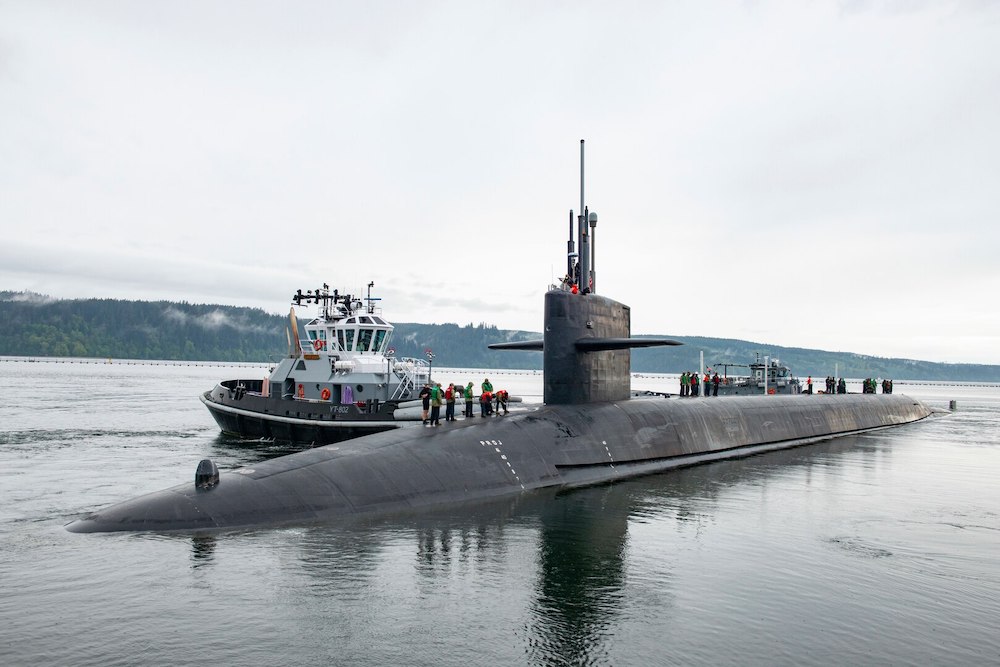
The New START data indicates that the United States as of March 1, 2022 deployed approximately 1,068 warheads on ballistic missile onboard its strategic submarines.
Compared with February 2011, the United States has reduced its total inventory of strategic launchers by 324, deployed launchers by 196, and deployed strategic warheads by 285. While important, the warhead reduction represents only a small fraction (about 8 percent) of the estimated 3,708 warheads that remain in the U.S. stockpile (just over 5 percent if counting total inventory of 5,428 stockpiled and retired (but yet to be dismantled) warheads).
The Russian Federation
The New START data shows Russia with an inventory of 761 strategic launchers, of which 526 are deployed with 1,474 warheads attributed to them. Compared with six months ago, this is a decrease of 1 deployed launcher and an increase of 16 deployed strategic warheads. The change reflects fluctuations caused by launcher maintenance and upgrade work to new systems.
Compared with February 2011, Russia has cut its total inventory of strategic launchers by 104, increased deployed launchers by 5, and decreased deployed strategic warheads by 63. This modest warhead reduction represents less than 2 percent of the estimated 4,477 warheads that remain in Russia’s nuclear weapons stockpile (roughly 1 percent if counting the total inventory of 5,977 stockpiled and retired (but yet to be dismantled) warheads).
The Russian New START reductions since 2011 are smaller than the US reductions because Russia had fewer strategic forces than the United States when the treaty entered into force.
That disparity remains today. Despite frequent claims by hardliners that Russia is ahead of the United States, the New START data shows that Russia has 160 deployed strategic launchers fewer than the United States, a significant gap that exceeds the number of missiles in an entire US Air Force ICBM wing. Despite its nuclear modernization program, Russia has so far not sought to reduce this gap by deploying more strategic launchers. Instead, the Russian launcher deficit has been increasing by about one-third since its lowest point in February 2018.
Instead of closing the launcher gap, the Russian military appears to try to compensate by increasing the number of warheads that can be carried on the newer missiles (SS-27 Mod 2, Yars, and SS-N-32, Bulava) that are replacing older types (SS-25, Topol, SS-N-18, Vysota, and SS-N-23, Sineva). Thanks to the New START treaty limit, many of these warheads are not deployed on the missiles under normal circumstance but are stored and could potentially be uploaded onto the launchers in a crisis. The United States also has such an upload capability for its larger inventory of launchers and therefore is not at a strategic disadvantage.
Two of Russia’s new strategic nuclear weapons (SS-19 Mod 4, Avangard, and SS-29, Sarmat) are covered by New START if formally incorporated. Other types (the Poseidon nuclear-powered torpedo, and the Burevestnik nuclear-powered ground-launched cruise missile) are not yet deployed and appear to be planned in relatively small numbers. They do not appear capable of upsetting the strategic balance in the foreseeable future. The treaty includes provisions for including new weapon types, if the two sides agree.
The sanctions in reaction to Russia’s invasion of Ukraine will likely slow Russia’s nuclear modernization in the next decade.
Inspections and Notifications
In addition to the aggregate data described above, the New START treaty also allows for up to 18 on-site inspections per year and notifications of launcher movements and activities. Up until April 2020, a total of 328 on-site inspections were conducted. Because of COVID-19, there have been no inspections since. The two countries have continued to exchange large numbers of notifications: a total of 23,559 as of March 31, 2022.
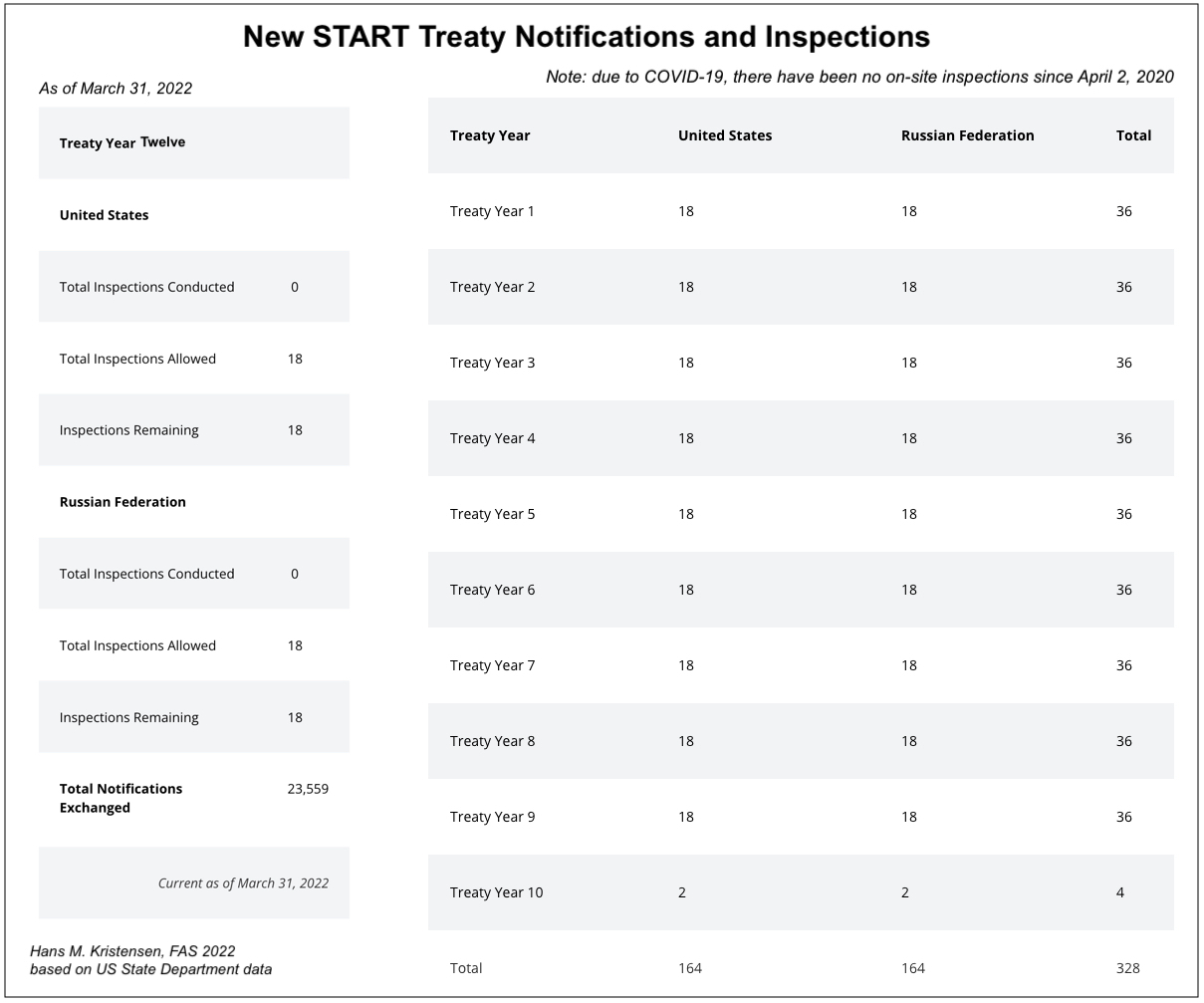
Looking Ahead
The continued complaince by the United States and Russia to the New START treaty and its data exchanges are extraordinary given the demise of treaties, agreements, and deep animosity and almost complete loss of trust. The treaty’s interactions between the two countries and the caps and predictability it provides on strategic offensive nuclear forces have never been more important since New START was negotiated more than a decade ago.
But the clock is running out. Although New START was extended in February 2021 for an additional five years, the treaty will expire in February 2026. Strategic stability talks between Russia and the United States have been disrupted by the war in Ukraine and seem unlikely to resume in the foreseeable future.
If New START is not followed by a new treaty by the time it expires in 2026, there will no limits on US and Russian nuclear forces for the first time the 1970s.
Moreover, political polarization makes it highly uncertain if the US Congress would approve a new treaty.
Short of a formal treaty, the two sides potentially could make an executive agreement and pledge to continue to abide by the New START limits even after the treaty officially expires.
The silver lining is that both countries have a strong interest in continuing to maintain limits on the other side’s strategic offensive nuclear forces. That is why it is important that hardliners are not allowed to misuse Russia’s invasion of Ukraine and China’s nuclear buildup to undermine New START and increase nuclear forces.
Additional information:
- Status of World Nuclear Forces
- Russian nuclear forces, 2022
- United States nuclear forces, 2021 [2022 version forthcoming]
This publication was made possible by generous support from the John D. and Catherine T. MacArthur Foundation, the New Land Foundation, the Ploughshares Fund, and the Prospect Hill Foundation. The statements made and views expressed are solely the responsibility of the author.
NNSA Removes F/A-18F Super Hornet From Nuclear Bomb Fact Sheet
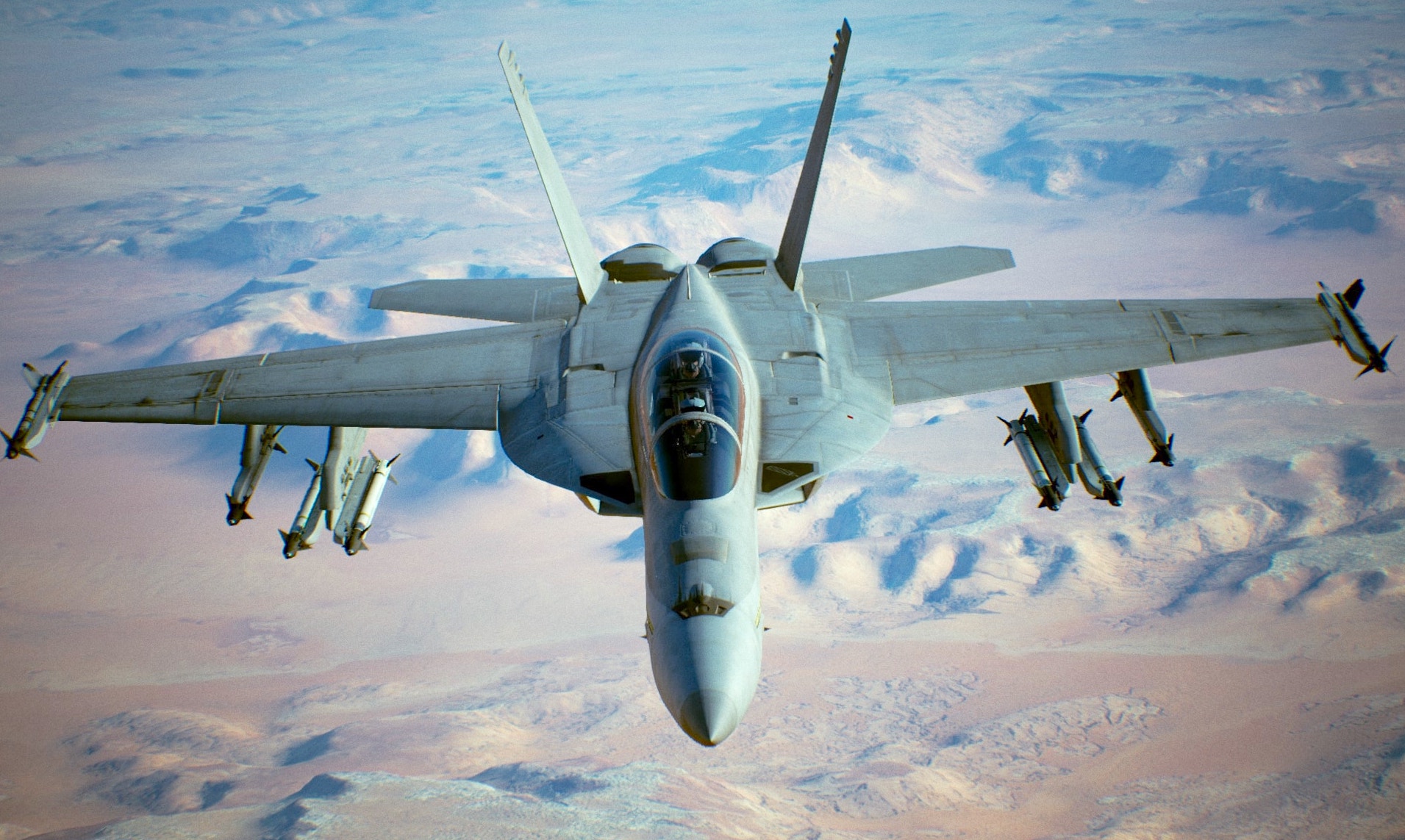
The F/A-18F is a two-seat version of the F/A-18E. Image: US Department of Defense
The National Nuclear Security Administration (NNSA) has quietly removed the F/A-18F Super Hornet from its B61-12 nuclear bomb fact sheet.
No public explanation has been offered for why the aircraft was removed or added in the first place.
The F/A-18F was added to a “November 2021” fact sheet published in early December, which listed the aircraft as one of three future aircraft platforms for the new B61-12 guided nuclear bomb (see image below). An earlier version from 2018 did not mention the F/A-18F.
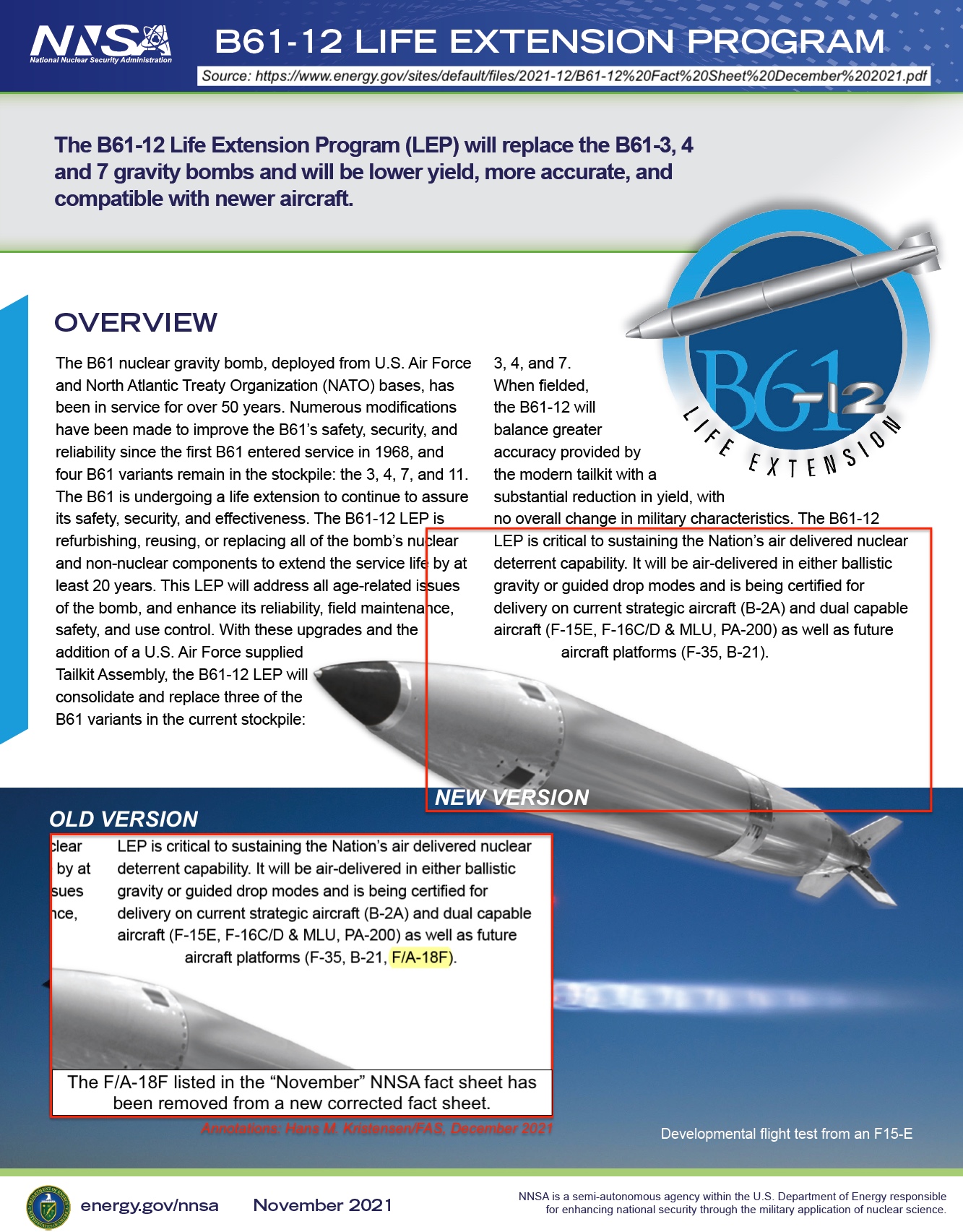
NNSA in 2021 added, and then deleted, the F/A-18F Super Hornet from its B61-12 nuclear bomb fact sheet.
The reason for including the F/A-18F was not stated. It could potentially indicate anticipated sale to Germany to replace its aging Tornado aircraft in the “nuclear sharing” strike mission, or that the U.S. Navy was planning to reintroduce nuclear capability on aircraft carriers (unlikely).
In response to questions from me, NNSA initially said neither of those were the reason for including the F/A-18F in the fact sheet. But after coordinating with the Defense Department, NNSA asked me to ignore that explanation saying the listing of the F/A-18 in the fact sheet was a mistake.
I have also asked the Defense Department, but it has not responded yet. Update: DOD said “there is not a requirement for the F/A-18F to be certified to carry the B61-12.”
What’s Going On?
The 2018 Nuclear Posture Review (NPR) considered many new nuclear weapons, but only two made it into the public version of the document as “nuclear supplements”: the low-yield W76-2 Trident warhead and the nuclear sea-launched cruise missile (SLCM-N). The W76-2 is already deployed, and the Biden administration’s NPR is currently considering whether to continue the SLCM-N. Doing so would violate the 1992 Presidential Nuclear Initiative.
One of the ideas proposed was reintroducing nuclear weapons on the aircraft carriers, an idea pushed by some former officials. The military rejected the idea. The carriers were denuclearized by the 1994 Nuclear Posture Review, the Navy does not want nukes back on them, but it would in any case probably have been the F-35C – not the F/A-18F.
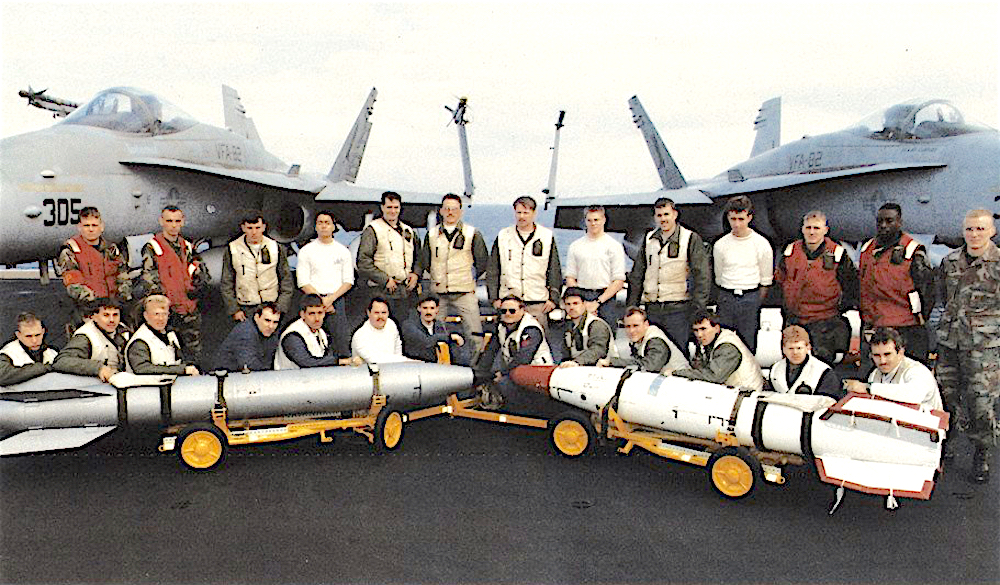
F/A-18 aircraft (background) used to be tasked with delivering nuclear bombs from aircraft carriers. The image shows B61 (left) and B43 nuclear bomb trainers on the deck of USS America (CV-66) during the 1991 Gulf War. Image: US Navy.
Instead, the appearance of the F/A-18F in the NNSA fact sheet probably reflected preparations to support Germany’s anticipated purchase the aircraft for its nuclear mission, and that the fact sheet was likely corrected because the German government has not publicly announced its selection of the F/A-18 (and the Parliament has not yet agreed to pay for it).
There is a lot of opposition in Germany to nuclear weapons and the question of whether to continue participation in the nuclear-sharing mission is politically sensitive. In 2020, Der Spiegel reported that the German defense minister had informed the Pentagon that Germany intended to buy the F/A-18 to replace the current Tornados (PA-200) in the “nuclear-sharing” strike mission. The report caused an uproar because the Parliament had not been informed or agreed. The minister later denied that a decision had been made, at least officially.
Pressure has been building on Germany to continue the nuclear-sharing mission. During the negotiations of the new coalition government, NATO secretary general Johan Stoltenberg issued what appeared to be an empty threat that “the alternative is that we easily end up with nuclear weapons in other countries in Europe, also to the east of Germany.”
The threat appeared empty because NATO had just endorsed a new defense plan to protect against “the growing threat from Russia’s missile systems” that included “improving the readiness” of NATO nuclear forces. Why NATO would choose to deploy its nuclear forces further east closer to those missiles is unclear. Moreover, deployment of nuclear weapons further east would require NATO consensus, which seems unlikely. But the threat was heard in Moscow and Stoltenberg later had to walk back his threat by reassuring that “We have no plans of stationing any nuclear weapons in other countries than [those that] already have these nuclear weapons….”
The tactical nuclear weapons mission in Europe was recently exercised in the Steadfast Noon exercise held in northern Italy in October. The exercise included German Tornado fighter-bombers. There are an estimated 100 US non-strategic B61 nuclear bombs deployed in Europe, including about 15 at Buchel Air Base in Germany (see map below).
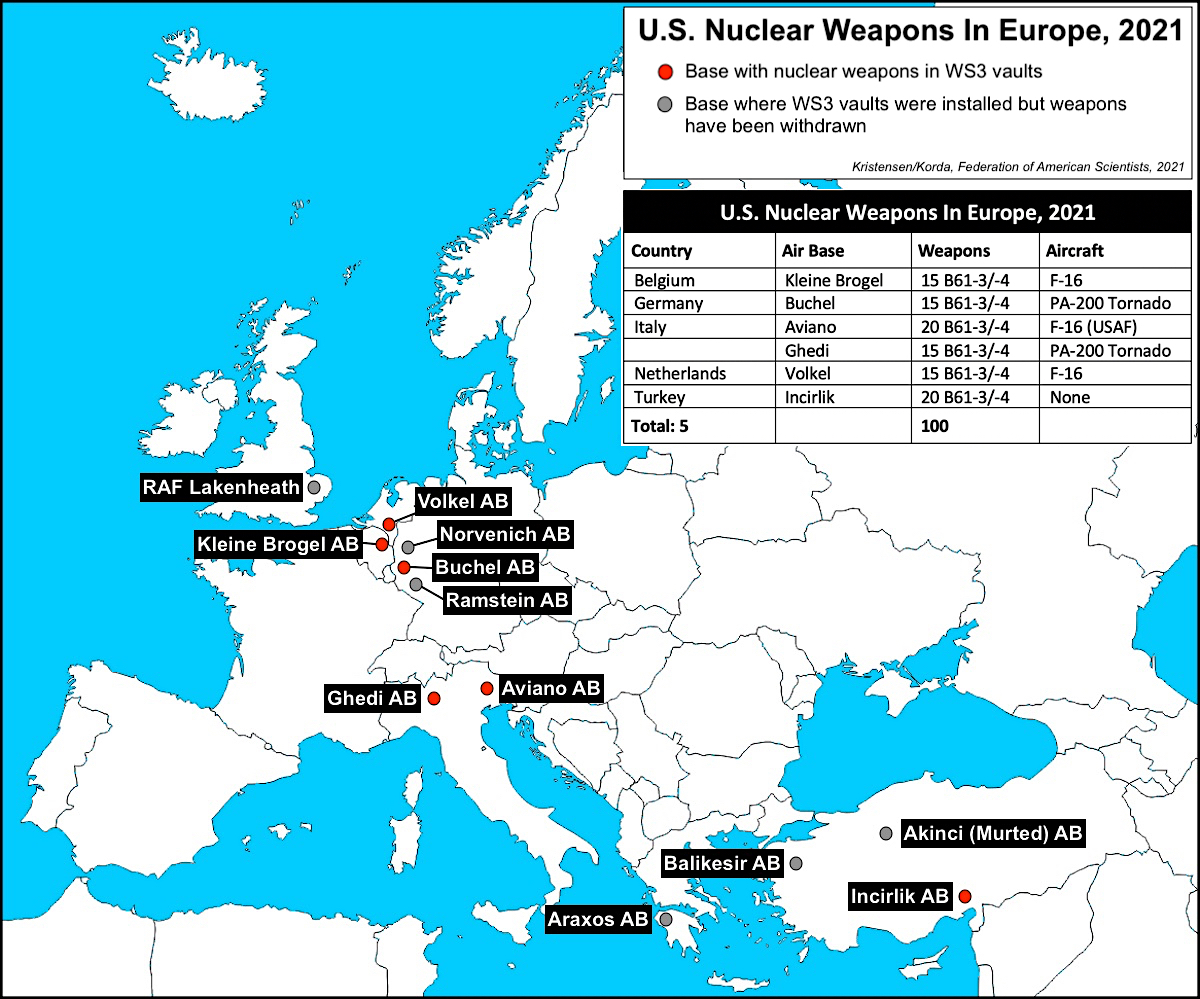
The US Air Force deploys an estimated 100 B61 nuclear bombs at five bases in six European NATO countries. There are no nuclear weapon storage facilities in the new Eastern European NATO countries.
The pressure apparently worked: The new German coalition government took office with a program that agreed to continue Germany’s participation in the nuclear-sharing mission. Although the US Navy has decided to end production of the F/A-18E/F after this year to focus resources on the F-35C, Boeing could continue production for foreign customers, including Germany. And Boeing officials reportedly expect Germany to issue a letter of request for the F/A-18F Super Hornet and EA-18G Growler in early 2022.
The F/A-18F has been removed from the fact sheet for now, but if Germany submits a formal request to buy the aircraft, NNSA will have to update the fact sheet once again.
Additional information:
- NNSA B61-12 Fact Sheet
- Video Shows Earth-Penetrating Capability of B61-12 Nuclear Bomb
- FAS Nuclear Notebook: United States nuclear weapons, 2021
- FAS overview: Status of World Nuclear Forces
This publication was made possible by generous support from the John D. and Catherine T. MacArthur Foundation, the New Land Foundation, the Ploughshares Fund, and the Prospect Hill Foundation. The statements made and views expressed are solely the responsibility of the author.
After Trump Secrecy, Biden Administration Restores US Nuclear Weapons Transparency
[Updated] The Biden administration yesterday afternoon declassified the number of nuclear weapons the United States possesses. The act reverses the secrecy of the Trump administration, which denied release of the number for three years, and restores the nuclear transparency of the Obama administration.
FAS’ Steve Aftergood asked for this information in March 2021. We have still not received an official response.
Although a victory for nuclear transparency, the data shows only very limited nuclear weapons reductions in recent years – a stark reminder of the international nuclear climate, domestic policies, and that a lot more work is needed to reduce nuclear dangers.
Stockpile Numbers
According to the new data, the United States possessed a total of 3,750 nuclear warheads in the Department of Defense nuclear weapons stockpile as of September 2020. That number is only 50 warheads less than our estimate of 3,800 warheads from early this year.
The 3,750-warhead number is only 72 warheads fewer than in September 2017, the last number made available before the Trump administration closed the books.
That reduction is by any measure mediocre. In its announcement about the new stockpile numbers, the US Department of State highlights that the current stockpile of 3,750 warheads “represents an approximate 88 percent reduction in the stockpile from its maximum (31,255) at the end of fiscal year 1967, and an approximate 83 percent reduction from its level (22,217) when the Berlin Wall fell in late 1989.” While that is true and an amazing accomplishment, the fact remains that the vast majority of that reduction happened in two phases during the H.W. Bush and W. Bush administrations. Since 2008 the reduction has been slow and limited. The trend is that the reduction is decreasing and leveling out.
A peculiar revelation in the new data is that it shows that the stockpile increased by 20 warheads between September 2018 and September 2019 when Trump was in office. The increase is not explained but one possibility is that it reflects the production of the new W76-2 low-yield warhead that the Trump administration rushed into production in response to what it said was Russia’s plans for first-use of tactical nuclear weapons. The first W76-2 was produced in February 2019, NNSA was scheduled to deliver all the warheads by end of Fiscal Year 2019, but the W76-2 wasn’t completed until June 2020. Arkin and Kristensen reported in January 2020 that the first W76-2s had been deployed, which was later confirmed by the Pentagon.
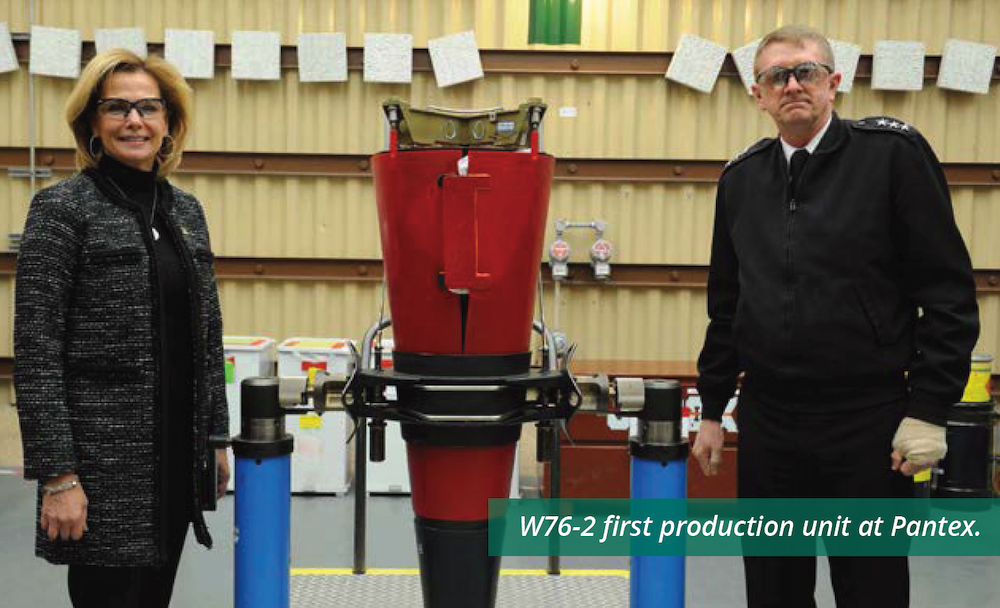
It is possible (but unconfirmed) that the 20-warhead stockpile increase between 2018 and 2019 was caused by production of the Trump administration’s W76-2 low-yield Trident warhead. Image: NNSA.
The Trump administration’s brief increase of the stockpile is only the second time the United States has increased its number of nuclear warheads since the Cold War. The first time was in 1995-1996 when the Clinton administration increased the stockpile by 107 warheads. Since the W76-2 production continued after September 2019, the increase of 20 warheads should not be misinterpreted as being the final number of W76-2 warheads. After the 2018-2019 increase, the stockpile number dropped again by 55 warheads.
Update: Another possibility for the brief stockpile increase is that a small number of retired warheads were returned to the stockpile. This could potentially be B83-1 bombs that the Trump administration decided to retain instead of retiring with the fielding of the B61-12. It could potentially also be retired warheads brought in as feedstock for new weapon systems such as the planned nuclear sea-launched cruise missile. We just don’t know at this point.
Apparently, the nuclear modernization program supported by both Republicans and most Democrats, will result in significant additional reductions of the stockpile. In 2016, the former head of the Navy’s Strategic Systems Program, Vice Admiral Terry Benedict, said that once the W76-1 warhead production was completed by the end of FY2019, the W76-0 warheads that had not been converted to W76-1 would be retired and the total number of W76 warheads in the stockpile decrease by nearly 50%.
At the same time, the Pentagon’s Principal Deputy Assistant Secretary of Defense for Nuclear, Chemical, and Biological Defense Programs, Arthur T. Hopkins, told Congress that production and fielding of the B61-12 bomb would “result in a nearly 50 percent reduction in the number of nuclear gravity bombs in the stockpile” and “facilitate the removal from the stockpile of the last megaton-class weapon––the B83-1.”
Production of the W76-1 has now been completed but the promised reduction is not yet visible in the stockpile data – unless the excess warheads were gradually removed during the production years. The B61-12 has not been fielded yet so the gravity bomb reduction presumably will not happen until the mid-2020s.
Whatever the number of the additional stockpile reduction is, it is not planned to be nice to Kremlin and Beijing but because the US military doesn’t need the excess warheads anymore. Whether Russia and China’s nuclear increases will cause the Biden administration to change the plan outlined by Benedict and Hopkins will be decided by the Nuclear Posture Review.
Dismantlement Numbers
The data also shows that the United States as of September 2020 had about 2,000 retired warheads in storage awaiting dismantlement. Retired warheads are owned by the Department of Energy and not part of the DOD stockpile.
That number matches the available data. Former Secretary of State John Kerry said in 2015 that there were about 2,500 retired weapons left (as of September 2014). Since then, 1,432 warheads have been dismantled and an additional 967 weapons retired, which would leave just over 2,000 warheads in the dismantlement queue.
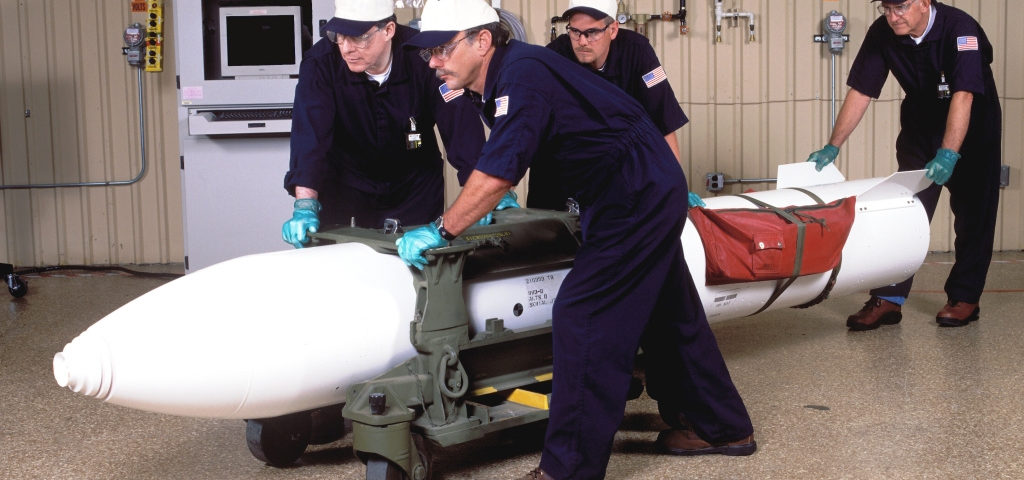
Approximately 2,000 retired warheads away dismantlement, including the B83 megaton gravity bomb. More are expected to follow during the next decade. Image: NNSA.
In our estimate from early this year, we thought the dismantlement queue had dropped to 1,750 warheads because we assumed the annual dismantlement rate had remained around 300. But as the data shows, both the Trump and Biden administrations reduced the number of warheads being dismantled per year.
In 2016, NNSA stated that it “will increase weapons dismantlement by 20 percent starting in FY 2018” and that the “accelerated rate will allow NNSA to complete the dismantlement commitment a year early, before the end of FY 2021.” NNSA reaffirmed in 2018, that all warheads retired prior to 2009 would be dismantled by end-FY 2022.
This pledge appears to have faded from recent documents after the 2018 Nuclear Posture Review was published. Instead, the annual number of warheads dismantled has decreased since FY 2018. Is it still the goal? Some of the warheads that should have been dismantled but are still with us reportedly include the W84 warheads from the ground-launched cruise missiles that were eliminated by the 1987 INF treaty and retired well before 2009.
Many of the warheads in the current dismantlement queue were retired after 2009. At the current rate of 184 warheads dismantled per year, it will take more than a decade to dismantle the current backlog. Once the excess W76s and old gravity bombs enter the queue, it will take even longer.
In Context
We commend the Biden administration for reversing the Trump administration’s shortsighted and counterproductive nuclear secrecy and restore transparency to the US nuclear weapons stockpile. This decision is a heavy lifting at a time when so-called Great Power Competition is overtaking defense and arms control analysis. The Federation of American Scientists has for years advocated for increased transparency of nuclear arsenals and have worked to provide that through our estimates of nuclear weapons arsenals.
Although the recent reductions shown in stockpile and dismantlement data are modest, to put it mildly, we believe declassification is the right decision because making the record public will help US diplomats make the case that the United States is continuing its efforts to reduce nuclear arsenals and increase nuclear transparency. This is especially important in the context of the upcoming January 2022 Review Conference for the Treaty on the Non-Proliferation of Nuclear Weapons. Dissatisfaction with the lackluster disarmament progress – and a belief that the nuclear-armed states are walking back decades of arms control progress with their excessive nuclear modernization programs and dangerous changes to operations and strategy – have fueled support for the Treaty on the Prohibition of Nuclear Weapons (TPNW).
The decision to disclose the stockpile and dismantlement data will also enhance the US credibility when urging other nuclear-armed states to be more transparent about their arsenals. We have no illusions that Russia or China will follow the example in the short term, but keeping the US numbers secret will certainly not help. And over time, the disclosure can help shape discussions and norms about nuclear transparency to shape future decisions. This is also important because the Trump secrecy recently provided cover for the United Kingdom to reduce information about its nuclear forces.
Hardliners will no doubt criticize the Biden administration’s decision to disclose the stockpile and dismantlement data. They will argue that past nuclear transparency has not given the United States any leverage, that nuclear-armed states previously have not followed the example, and it that makes the United States look naive – even irresponsible – in view of Russia and China’s nuclear secrecy and build-up.
On the contrary: without transparency the United States has no case. Past transparency has given the United States leverage to defend its record and promote its policies in international fora, dismiss rumors and exaggerations about its nuclear arsenal, and publicly and privately challenge other nuclear-armed states’ secrecy and promote nuclear transparency. And since the disclosure does not reveal any critical national security information, there is no reason to classify the stockpile and dismantlement data.
Hardliners obviously will have to acknowledge that the data shows that there has been no unilateral US disarmament but only a very modest reduction in recent years. And although there appear to be additional unilateral reductions built into the modernization programs, those are actually programs that have been supported and defended by the hardliners.
Now it is up to the Biden administration’s Nuclear Posture Review to articulate how and to what extent those plans support and strengthen US national security and nonproliferation objectives. Arms control obviously will have to be part of that assessment. The declassified stockpile and dismantlement data will help make the case that additional reductions are both needed and possible.
Background Information:
- US Department of State, Transparency in the U.S. Nuclear Weapons Stockpile, Fact Sheet, October 5, 2021
- “United States Nuclear Forces, 2021,” FAS Nuclear Notebook, Bulletin of the Atomic Scientists, March/April 2021
- “Pentagon Slams Door On Nuclear Weapons Stockpile Transparency,” FAS Strategic Security Blog, April 17, 2019
- Status of World Nuclear Forces, Federation of American Scientists global arsenal page
This article was made possible by generous support from the John D. and Catherine T. MacArthur Foundation, the New Land Foundation, the Prospect Hill Foundation, and the Ploughshares Fund. The statements made and views expressed are solely the responsibility of the authors.
What Is the Sole Purpose of U.S. Nuclear Weapons?
Summary
- Prior to assuming office, President Biden indicated that he would establish that “the sole purpose of our nuclear arsenal is to deter—and, if necessary, retaliate for—a nuclear attack against the United States and its allies.”
- Sole purpose should be understood as a central component of an integrated deterrence strategy that can effectively manage the risk of nuclear escalation in a limited conflict as well as the rising stability risks from nonnuclear weapons.
- Sole purpose could significantly reduce the risk of unintended escalation and increase the credibility of more flexible and realistic nonnuclear response options in a range of importance contingencies.
- In order to attain its intended benefits, declaratory policy must be reflected in force structure and planning.
- The president’s existing language on sole purpose provides considerable flexibility for the administration to define the doctrine, but does not itself provide clear guidance for strategy, force structure, or for related declaratory policies like “no first use.”
- Defining sole purpose is a critical task for the administration’s defense policy review.
- As a central component of an integrated defense policy that will strengthen US deterrence and assurance credibility, sole purpose should be defined at the level of the NDS.
- A sole type definition would state that the United States would consider nuclear use in response to a certain type of attack, having modest effects on a narrow set of plans but few effects on force structure.
- A sole function definition would define what is and what is not a requirement of deterrence, potentially removing certain strategic or nonstrategic roles of nuclear weapons.
Depending on how it is defined, sole purpose could have transformational effects on nearly every aspect of nuclear weapons policy or relatively modest effects. It could accommodate or incorporate a range of related policy options, like a deterrence-only posture or no first use.
- Fully implementing a sole purpose policy is critical to attaining its benefits.
- A simple declaratory statement is not a complete sole purpose policy. Because any statement is likely to be ambiguous, sole purpose should also consist of a set of presidential directives that determine how the policy will be affect force structure and planning.
- By eliminating one or more of the requirements that structure US nuclear forces, a sole function definition could potentially have significant effects on a range acquisition decisions and plans.
- If the president concludes that sole purpose has implications for force structure or force posture, the administration should ensure that these changes are made before the presidential term is concluded.
- Following a decision to adopt sole purpose, civilian officials should review existing operational plans and concepts to ensure that they comport with the president’s guidance for escalation management of a conflict with a nuclear-armed adversary.
- Embedding the policy in plans, force structure, and allied consultations is critical to achieving its benefits and reducing the risk that it is reversed by a future president, which would be highly risky.
- If defined, implemented, and communicated as a part of an effective integrated deterrence posture, sole purpose could strengthen assurance of allies.
- Some allies will be understandably apprehensive about any shift in US nuclear weapons policy in the current environment.
- Allies should be consulted closely as sole purpose is being defined, as it is released, and as it is being implemented.
In January 2021, President Biden assumed office after having made unusually explicit commitments to reduce the role of nuclear weapons in US national security strategy. In his primary articulation of his campaign’s foreign policy, BJoseph R. Biden, “Why American Must Lead Again: Rescuing US Foreign Policy after Trump,” Foreign Affairs 99 (2020): 64.iden declared that “the sole purpose of the US nuclear arsenal should be deterring—and if necessary, retaliating against—a nuclear attack.”1 Since assuming office, Biden has not repeated the pledge, though his initial national security guidance and his Secretary of State have reiterated the goal of reducing reliance on nuclear weapons.2 As the Pentagon begins its review of nuclear weapons policy, Biden and his national security officials will have to determine whether to adopt sole purpose and, if so, what it means. The established language on sole purpose offers the administration considerable latitude in how it chooses to reduce reliance on nuclear weapons. Depending on how sole purpose is defined and implemented, it could have transformative consequences for nuclear force structure and strategy, or it could end up as a rhetorical commitment that has few practical effects at all.
Though the language dates back decades, there has never been a precise or agreed definition of sole purpose. The first published use of the phrase is in a piece Albert Einstein related to the eminent journalist Raymond Swing that was published in the Atlantic in 1947. Einstein argued while the United States must stockpile the bomb, it should forswear its use. “Deterrence should be the only purpose of the stockpile of bombs.” If the United Nations were granted international control over atomic energy, as President Truman had proposed, it should be “for the sole purpose of deterring an aggressor or rebellious nations from making an atomic attack.3 Since the idea was popularized in the 1960s, sole purpose has become a persistent staple in ongoing debates about the role of nuclear weapons, but it has rarely been attached to a precise definition or a plan to implement it.
Sole purpose is more ambiguous than other declaratory policy proposals (such as no first use) because it purports to define, or constrain, the purpose of nuclear weapons. Depending on how the terms of the statement are defined and how the statement is implemented in practice, its effects could be broad, narrow, restrictive, permissive, or ambiguous. For example, President Biden’s sole purpose language could be construed to proscribe nuclear weapons from performing a wide range of functions or from being used in wide ranges of contingencies. Slight variations in the wording of a sole purpose declaration can produce dramatically different policies and be perceived differently by allies and adversaries, who will examine the policy closely. Depending on how sole purpose is defined and implemented, sole could reduce or eliminate requirements for each piece of the triad or for nuclear use in a variety of different contingency plans.
Sole purpose is one potential option in declaratory policy, that aspect of nuclear weapons policy that publicly communicates when and why the United States would consider the use of nuclear weapons. It can be combined with or can subsume a range of other potential declaratory policy options. Because the president has sole authority to order the use of a nuclear weapon, only the president can set limits on that power. Though changes in declaratory policy should consider the views of civilian national security officials, uniformed military officials, members of Congress, US allies, and the American public, the president should provide clear guidance on how to modify US declaratory policy. Like all presidents, President Biden should provide clear guidance to the officials conducting the national defense strategy about nuclear declaratory policy.
Because sole purpose could potentially be defined in many different ways, some definitions will be better or worse. Advocates or opponents should be clear about what constitutes a better or worse definition. The administration should not accept the argument that a good definition is one that preserves existing force structure or plans, maintains ambiguity for its own sake, or comports with the preferences of certain allies or services. This piece argues that a good definition of sole purpose is one that assists with the development and implementation of a credible, integrated posture by which the United States and its allies deter aggression and nuclear use; reflects the president’s preferences about how to manage escalation in limited conflicts with nuclear-armed adversaries as well as his assessment of the requirements of deterring a major strategic attack; reduces the risk of misperception and adversary nuclear first use incentives; and can be implemented in force structure and plans so that it is resilient to leadership changes in the United States. Because the president has expressed a preference to reduce the nation’s reliance on nuclear weapons, a good definition of sole purpose should help to do so in ways consistent with his preferences.
This piece examines the range of options available to officials working to define sole purpose and reduce reliance on nuclear weapons. It explores the practical implications of different definitions of sole purpose and the steps necessary to ensure that they are implemented in a way that is responsible, effective, and most likely to endure over time. There are two central arguments. First, sole purpose should not be understood as a nuclear declaratory policy but as critical component in an integrated deterrence strategy. Understood in this way, sole purpose is not only a valuable means of reducing the risk of nuclear escalation and of meeting US commitments to reduce reliance on nuclear weapons but because it is a substantive judgment about how US nuclear and nonnuclear forces can best manage escalation in a limited conflict with a nuclear-armed adversary. Second, an effective sole purpose policy cannot simply be a sentence in a paragraph on nuclear declaratory policy. If the administration is serious about attaining the benefits of sole purpose, the policy should be comprised of the declaratory statement, additional language to clarify and contextualize the policy, and a set of directives that communicate the president’s guidance for how the policy should affect force structure and plans.
Each of these arguments is critical for attaining the benefits of sole purpose and for maintaining an effective deterrence posture. Sole purpose will be a contentious idea under any circumstances. Allied governments, advocates of various aspects of the current nuclear weapons policies, and political opponents are understandably concerned about the president’s statements. Clearly defining the policy, articulating how it will strengthen an integrated deterrence policy, and moving forward with implementation will help to convince allies and many deterrence experts that sole purpose will increase rather than decrease deterrence credibility.
First New START Data After Extension Shows Compliance
The first public release of New START aggregate numbers since the United States and Russia in February extended the agreement for five years shows the treaty continues to limit the two nuclear powers strategic offensive nuclear forces.
Continued adherence to the New START limits is one of the few positive signs in the otherwise frosty relations between the two countries.
The ten years of aggregate data published so far looks like this:
Combined Forces
The latest set of this data shows the situation as of March 1, 2021. As of that date, the two countries possessed a combined total of 1,567 accountable strategic missiles and heavy bombers, of which 1,168 launchers were deployed with 2,813 warheads. That is a slight decrease in the number of deployed launchers and warheads compared with six months ago (note: the combined warhead number is actually about 100 too high because each deployed bomber is counted as one weapon even though neither country’s bombers carry weapons under normal circumstances).
Compared with September 2020, the data shows the two countries combined increased the total number of strategic launchers by 3, decreased combined deployed strategic launchers by 17, and decreased the combined deployed strategic warheads by 91. Of these numbers, only the “3” is real; the other changes reflect natural fluctuations as launchers move in and out of maintenance or are being upgraded.
In terms of the total effect of the treaty, the data shows the two countries since February 2011 combined have cut 422 strategic launchers from their arsenals, reduced deployed strategic launchers by 235, and reduced the number of deployed strategic warheads by 524. However, it is important to remind that this warhead reduction is but a fraction (just over 6 percent) of the estimated 8,297 warheads that remain in the two countries combined nuclear weapons stockpiles (just over 4 percent if counting their total combined inventories of 11,807 stockpiled and retired (but yet to be dismantled) warheads).
The United States
The data shows the United States currently possessing 800 strategic launchers, exactly the maxim number allowed by the treaty, of which 651 are deployed with 1,357 warheads attributed to them. This is a decrease of 24 deployed strategic launchers and 100 deployed strategic warheads over the past 6 months. These are not actual decreases but reflect normal fluctuations caused by launchers moving in and out of maintenance. The United States has not reduced its total inventory of strategic launchers since 2017.
The aggregate data does not reveal how many warheads are attributed to the three legs of the triad. The full unclassified data set will be released later. But if one assumes the number of deployed bombers and deployed ICBMs are the same as in the September 2020 data, then the SSBNs carry 909 warheads on 200 deployed Trident II SLBMs. That is a decrease of 100 warheads on the SSBN force compared with September, or an average of 4-5 warheads per deployed missile. Overall, this accounts for 67 percent of all the 1,357 warheads attributed to the deployed strategic launchers (nearly 70 percent if excluding the “fake” 50 bomber weapons included in the official count).
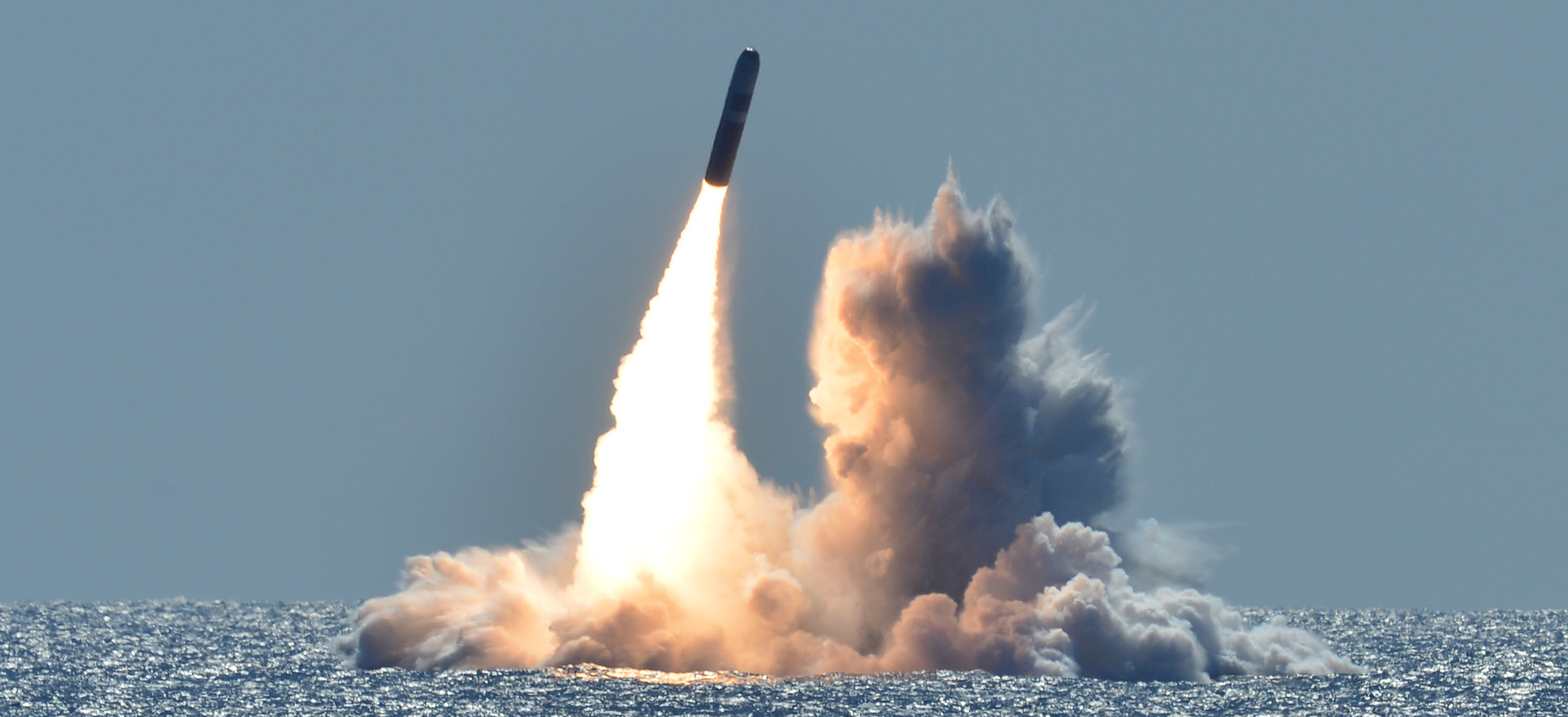
The New START data indicates that the United States as of March 1, 2021 deployed approximately 909 warheads on ballistic missile onboard its strategic submarines.
Compared with February 2011, the United States has reduced its inventory of strategic launchers by 324, deployed launchers by 231, and deployed strategic warheads by 443. While important, the warhead reduction represents only a small fraction (about 12 percent) of the 3,800 warheads that remain in the U.S. stockpile (less than 8 percent if counting total inventory of 5,800 stockpiled and retired (but yet to be dismantled) warheads).
The Russian Federation
The New START data shows Russia with an inventory of 767 strategic launchers, of which 517 are deployed with 1,456 warheads attributed to them. Compared with six months ago, this is an increase of 7 deployed launchers and 9 deployed strategic warheads. The change reflects fluctuations caused by launcher maintenance and upgrade work to new systems.
Compared with February 2011, Russia has cut its inventory of strategic launchers by 98, deployed launchers by 4, and deployed strategic warheads by 81. This modest warhead reduction represents less than 2 percent of the estimated 4,497 warheads that remain in Russia’s nuclear weapons stockpile (only 1.3 percent if counting the total inventory of 6,257 stockpiled and retired (but yet to be dismantled) Russian warheads).
Compared with 2011, the Russian reductions accomplished under New START are smaller than the U.S. reductions because Russia had fewer strategic forces than the United States when the treaty entered into force in 2011.
Build-up, What Build-up?
With frequent claims by U.S. officials that Russia is increasing its nuclear arsenal, which may be happening in some categories, it is interesting that despite a significant modernization program, the New START data shows this increase is not happening in the size of Russia’s accountable strategic nuclear forces. (The number of strategic-range nuclear forces outside New START is minuscule.)
On the contrary, the New START data shows that Russia has 134 deployed strategic launchers less than the United States, a significant gap roughly equal to the number of missiles in an entire US Air Force ICBM wing. It is significant that Russia despite its modernization programs so far has not sought to reduce this gap by deploying more strategic launchers. Instead, the Russian launcher deficit has been increasing by nearly one-third since its lowest point in February 2018.

Although Russia is modernizing its nuclear forces, such as those of this SS-27 Mod 2 (RS-24, Yars) ICBM exercise near Bernaul, this has not yet resulted in an increase of its strategic nuclear weapons.
Instead, the Russian military appears to try to compensate for the launcher disparity by increasing the number of warheads that can be carried on the newer missiles (SS-27 Mod 2, Yars, and SS-N-32, Bulava) that are replacing older types (SS-25, Topol, and SS-N-18, Vysota). Thanks to the New START treaty limit, many of these warheads are not deployed on the missiles under normal circumstance but are stored and could potentially be uploaded onto the launchers in a crisis. The United States also has such an upload capability for its larger inventory of launchers and therefore is not at a strategic disadvantage.
Two of Russia’s new strategic nuclear weapons (SS-19 Mod 4, Avangard, and SS-29, Sarmat) are covered by New START if formally incorporated. Other types (Poseidon nuclear-powered torpedo, and Burevestnik nuclear-powered ground-launched cruise missile) are not yet deployed and appear to be planned in relatively small numbers. They do not appear capable of upsetting the strategic balance in the foreseeable future. The treaty includes provisions for including new weapon types, if the two sides agree.
Inspections and Notifications
In addition to the New START data, the U.S. State Department has also updated the overview of part of its treaty verification activities. The data shows that the two sides since February 2011 have carried out 328 on-site inspections of each other’s strategic nuclear forces and exchanged 21,727 notifications of launcher movements and activities. Nearly 860 of those notifications were exchanged since September 2020.
Importantly, due to the Coronavirus outbreak, there have been no on-site inspections conducted since April 1, 2020. Instead, notification exchanges and National Technical Means of verification have provided adequate verification. Nonetheless, on-site inspection can hopefully be resumed soon.
This inspection and notification regime and record are crucial parts of the treaty and increasingly important for U.S.-Russian strategic relations as other treaties and agreements have been scuttled.
Looking Ahead
Although the New START treaty has been extended for five years and it appears to be working, that is no reason to be complacent. The United States and Russia should undertake detailed and ongoing negotiations about what a follow-on treaty will look like, so they are ready well before the five-year extension runs out. The incompetent and brinkmanship negotiation style of the Trump administration fully demonstrated the risks and perils of waiting to the last minute. The Biden administration can and should do better.
Additional information:
This publication was made possible by generous support from the John D. and Catherine T. MacArthur Foundation, the New Land Foundation, the Ploughshares Fund, and the Prospect Hill Foundation. The statements made and views expressed are solely the responsibility of the author.

